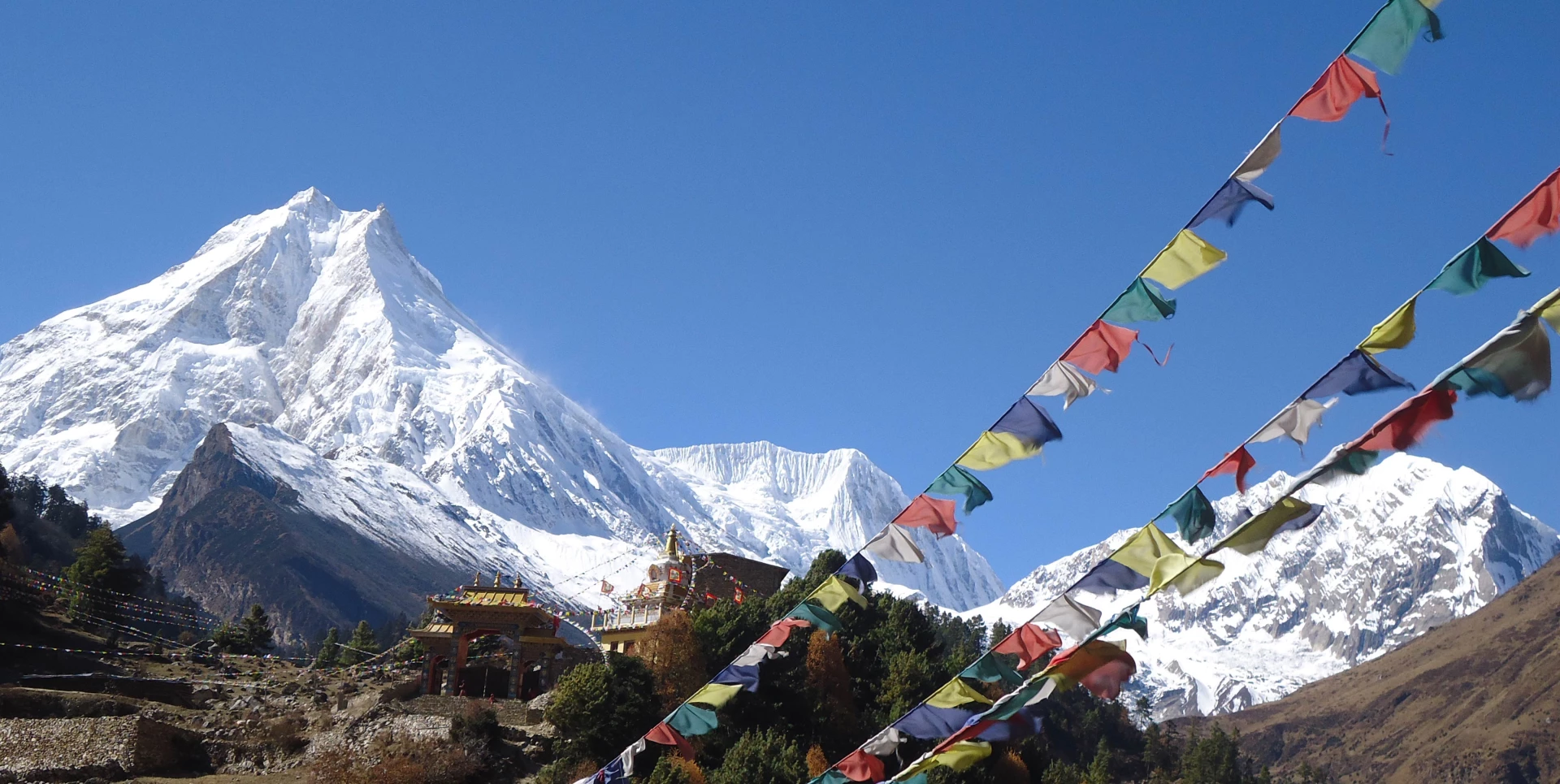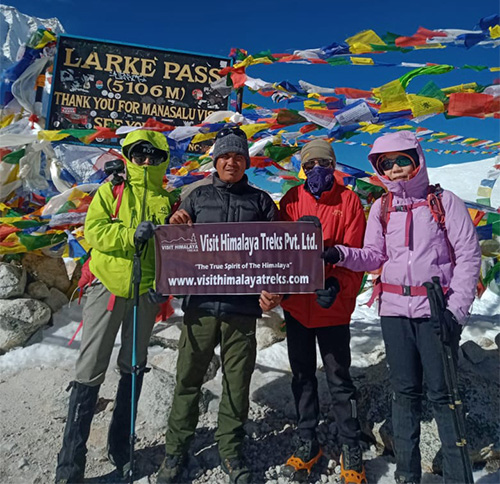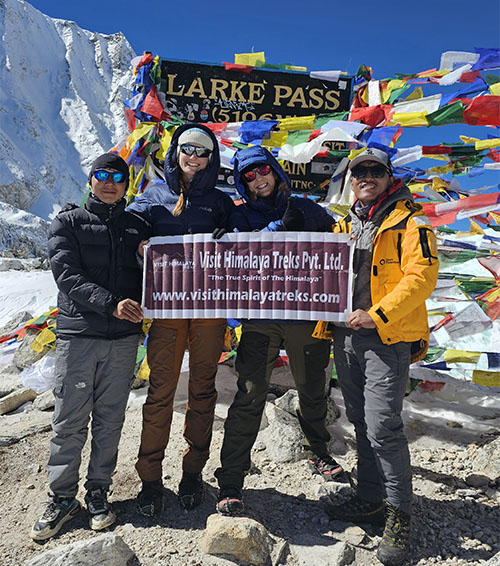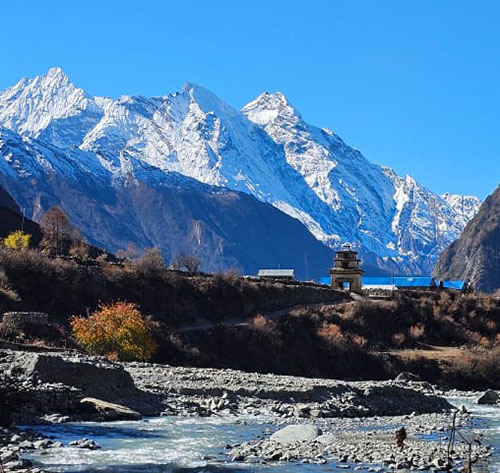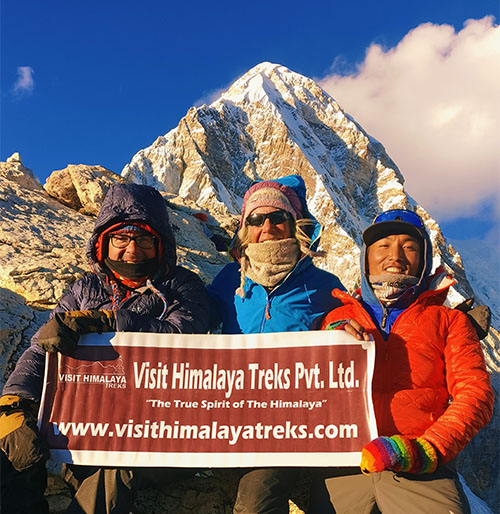If you're a passionate trekker seeking an adventure of a lifetime, look no further than Nepal. With its towering Himalayan peaks, enchanting valleys, and rich cultural heritage, this Himalayan nation beckons you to explore its breathtaking trails. In this blog, we will present the 20 best treks in Nepal, where you can immerse yourself in nature's grandeur, discover hidden gems, and create memories that will last forever. Get ready to embark on an exhilarating journey through the heart of the Himalayas.
Everest Base Camp Trek in the heart of Khumbu Valley.
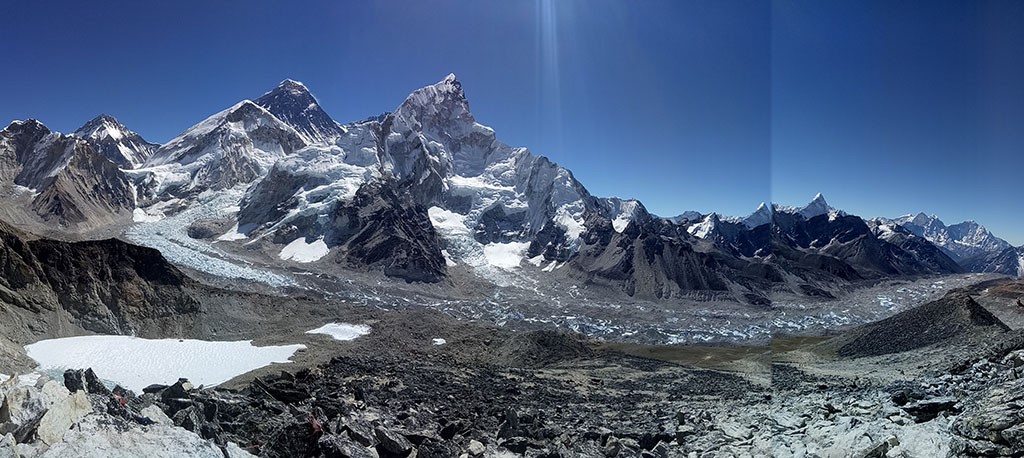
Everest Base Camp Trek's Trip Fact
| Maximum Elevation: |
5545 meters, Kala Patthar
|
| Trip Duration |
17 days
|
| Trek Difficulty: |
Demanding
|
|
Accommodation Type:
|
Teahouse / Lodge Trek
|
|
Best Season:
|
October to December in the Autumn season. March to May in the Spring season.
|
|
Required Trek Permits:
|
Sagarmatha National Park entry permits & Pasang Lamu municipality entry permits.
|
|
Starting and Ending Point:
|
Lukla.
|
EBC Trek's Highlights:
- Stunning views of the world's highest peak, Mount Everest.
- Trekking through the Sagarmatha National Park, a UNESCO World Heritage Site.
- Visiting the Sherpa villages and experiencing their unique culture and hospitality.
- Reaching the iconic Everest Base Camp, where climbers start their ascent to the summit.
Everest Base Camp Trek's altitude profile
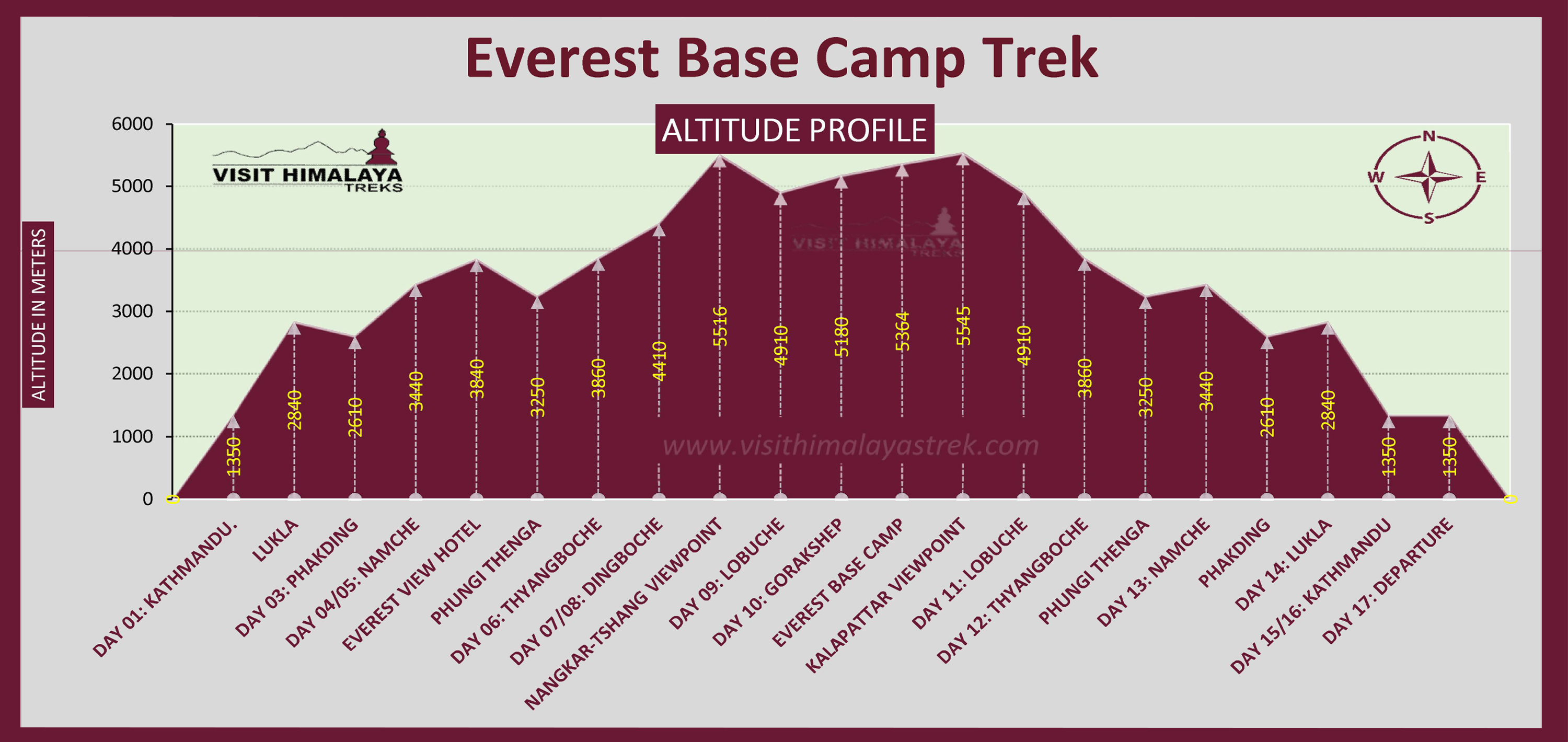
Undoubtedly the most iconic treks in Nepal "The Everest Base Camp Trek". It is renowned as one of the world's most exquisite and well-known routes for trekking. It transcends the mere act of climbing a mountain and becomes a transformative journey through the breathtaking landscapes of the Himalayas. The trek presents an opportunity to witness the grandeur of Mount Everest (8,848 m), the highest peak on Earth, as well as numerous other majestic summits.
During this remarkable adventure, you will traverse charming Nepalese villages, verdant Himalayan forests, rushing streams, and snow-covered terrains until you ultimately reach the base camp of Mount Everest. Undoubtedly, the Everest Base Camp Trek is a highly sought-after expedition worldwide, attracting adventure enthusiasts from all corners of the globe.
Given the high altitude and ever-changing weather conditions in the region, it is advisable to undertake the trek with a knowledgeable guide and in a small group. Safety should always remain a top priority. However, due to the trek's immense popularity, the main trails are often quite crowded.
In addition to reaching the foot of the magnificent Mount Everest, this journey offers mesmerizing views of the Solu Khumbu region. The route also takes you through Namche Bazaar, a bustling trading town situated at an elevation of 3,440 meters, acting as a bridge between Tibet and the Sherpa community. Here, you will have the opportunity to immerse yourself in the Sherpa culture and witness their cherished traditions.
Following the path alongside the Dudh Kosi River through the valley, you will meander through picturesque forests and charming villages until the trek concludes in Lukla, where you can enjoy a well-deserved rest. It is important to note that this trip is suitable for physically fit and experienced hikers, requiring prior physical preparation and endurance training.
For those who prefer a more convenient alternative, the Everest Base Camp Helicopter Tour provides an excellent opportunity to witness the splendor of Everest without the need for trekking.
Gokyo Lakes Cho La Pass EBC Trek - Ultimate Trek to Everest region of Nepal
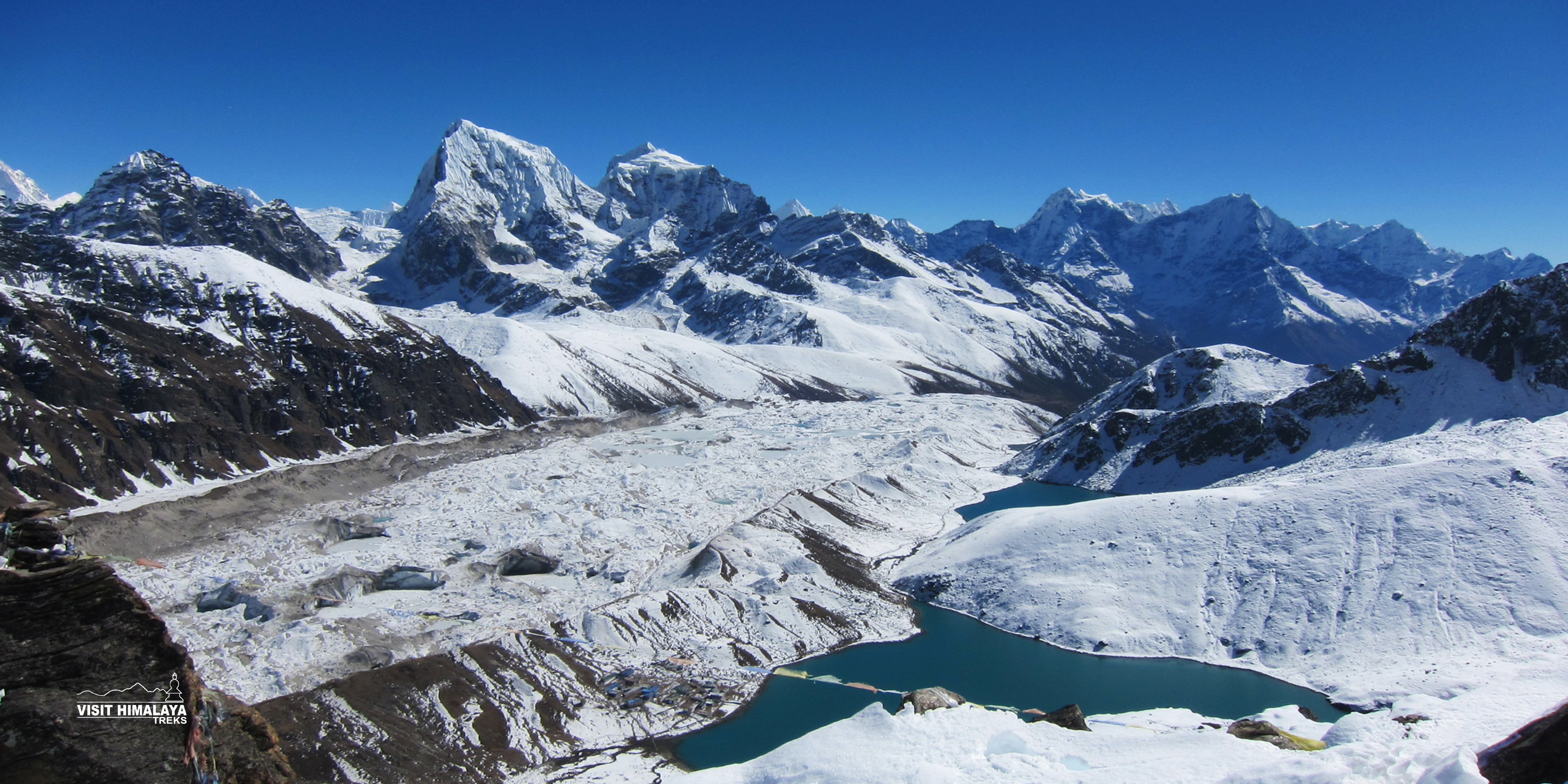
Gokyo Lakes Cho La Pass EBC Trek's Trip Fact
|
Maximum Elevation:
|
5545 meters, Kala Patthar
|
|
Trek Duration:
|
22 days
|
|
Best Season:
|
March-May, and October- November
|
|
Trek Category:
|
Demanding
|
|
Accommodation Type:
|
Teahouse
|
|
Restricted Area:
|
No
|
|
Required Trekking Permits:
|
Sagarmatha National Park entry permits & Pasang Lamu municipality entry permits.
|
|
Starting and Ending Point:
|
Lukla
|
Gokyo Lakes Cho La Pass EBC Trek's Highlights:
- Exploring the serene Gokyo Lakes and witnessing the breathtaking reflections of the Himalayan peaks.
- Crossing the challenging Cho La Pass, which offers panoramic views of the surrounding mountains.
- Visiting the Everest Base Camp and enjoying close-up views of Mount Everest.
- Experiencing the vibrant culture and traditions of the Sherpa people.
Gokyo Lakes Cho La Pass EBC Trek's altitude profile
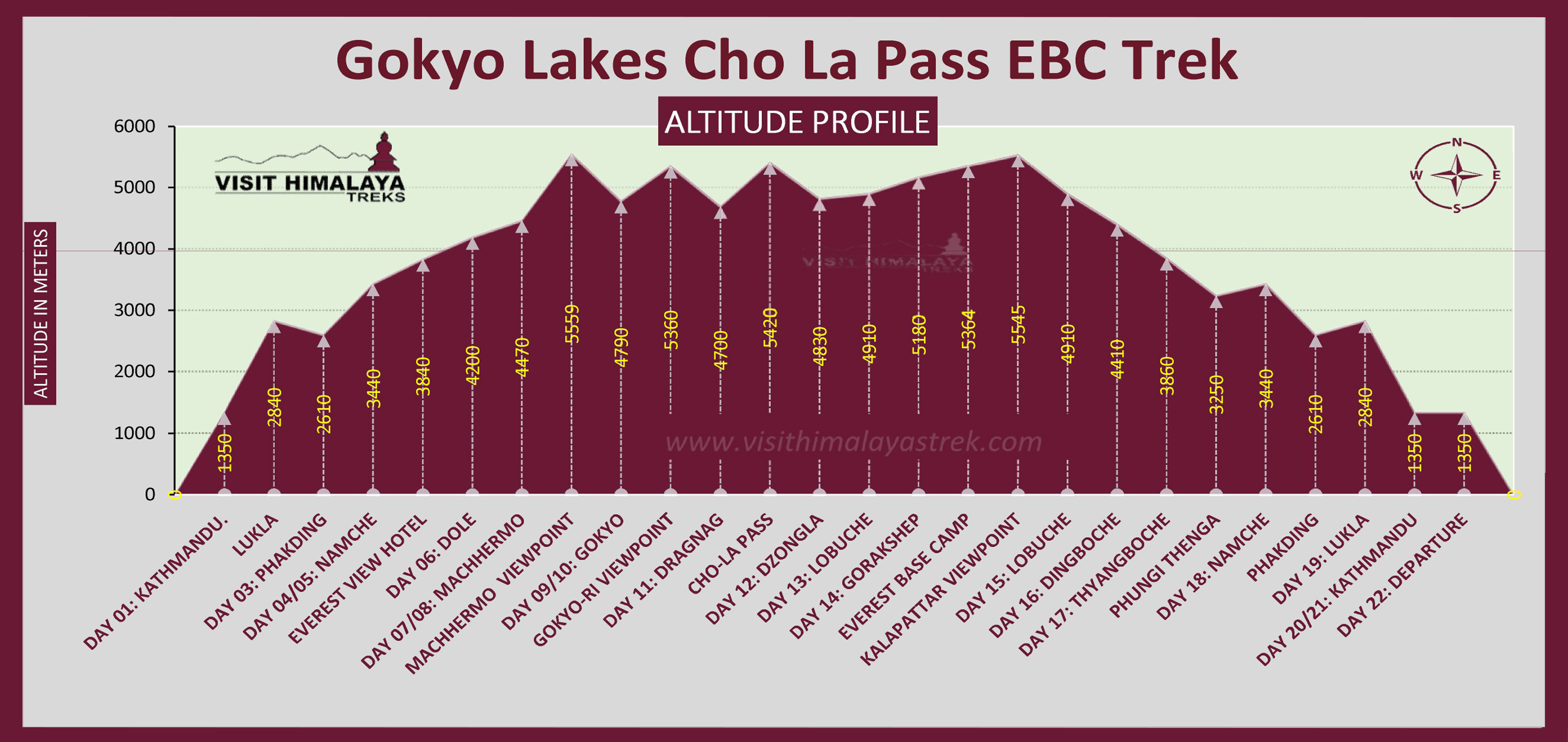
The Everest Chola Pass Trek with Gokyo Lakes and Base Camp offers comprehensive 22-day treks in Nepal for adventurous individuals who enjoy challenging mountain terrain in Nepal's Khumbu region. This trek is particularly suited for proficient and passionate high-altitude trekkers seeking captivating experiences amidst mountains, glaciers, valleys, mountain passes, and lakes. Considered the most beautiful and breathtaking treks in Nepal, it encompasses popular landmarks like Namche Bazaar, Tengboche Monastery, Gorak Shep, and Everest Base Camp, while also including a visit to the stunning Gokyo Lakes via the high altitude Cho La Pass (5,330m).
A major highlight of this trek is the steep ascent to Gokyo Ri (5,357m), offering breathtaking views of Mount Everest, Cho Oyu, Lhotse, and Makalu. Ascending this climb not only offers breathtaking panoramic views of the mountains but also serves as preparation for the demanding journey ahead, encompassing the traversal of the Cho La Pass.
The Gokyo Lakes Cho La Pass EBC trek continues to Gorak Shep, Everest Base Camp, and Kalapatthar (Everest View Point), allowing trekkers to bask in a feeling of achievement. While some days require 8 to 9 hours of walking. However, the majority of days are 5 to 6 hours long, providing an incredible experience for those with stamina and a thirst for adventure.
So, it's important to note that the Everest Base Camp - Kalapather and Gokyo Lake Trek require good physical fitness, as it involves walking on rugged mountain terrain for 6 to 7 hours a day. However, if you have any doubts about your physical ability, worry not! Our professional mountain guide and staff will take care of everything, ensuring your interests, needs, and safety are prioritized. The ascent is gradual, ensuring proper acclimatization and minimizing the risk of mountain sickness.
Starting from Lukla after a short 40-minute flight from Kathmandu, the 22-day trek encompasses Everest Base Camp and Kalapatthar first, followed by crossing the Cho La Pass and exploring the Gokyo Lakes. The trek's highlights include spectacular close-up views of Mt. Everest and the scenic Gokyo Valley, which is a hidden gem in the Himalayas. The trek also offers opportunities to appreciate the region's rich cultural heritage through visits to medieval monasteries, Mani walls, prayer wheels, and interaction with the Sherpa and Tibetan communities.
Although the trek presents challenges, such as long and strenuous walking days, the rewards are well worth it in terms of personal achievement and the opportunity to capture stunning photographs. That's the reason this journey is listed among the best treks in Nepal.
During the trek, you will journey through enchanting landscapes, including Rhododendron and pine forests, waterfalls, high pasturelands, chortens, and fluttering prayer flags. As you approach the Ngozumpa Glacier, you will be rewarded with a challenging climb that leads to the mesmerizing turquoise waters of three Gokyo Lakes. For those who prefer a different experience, but still want to witness the beauty of the Gokyo Cho La Pass and Everest Base Camp, an alternative option is an Everest Base Camp Helicopter tour.
Everest Three Passes Trek - Everest High Passes Treks in Khumbu Valley
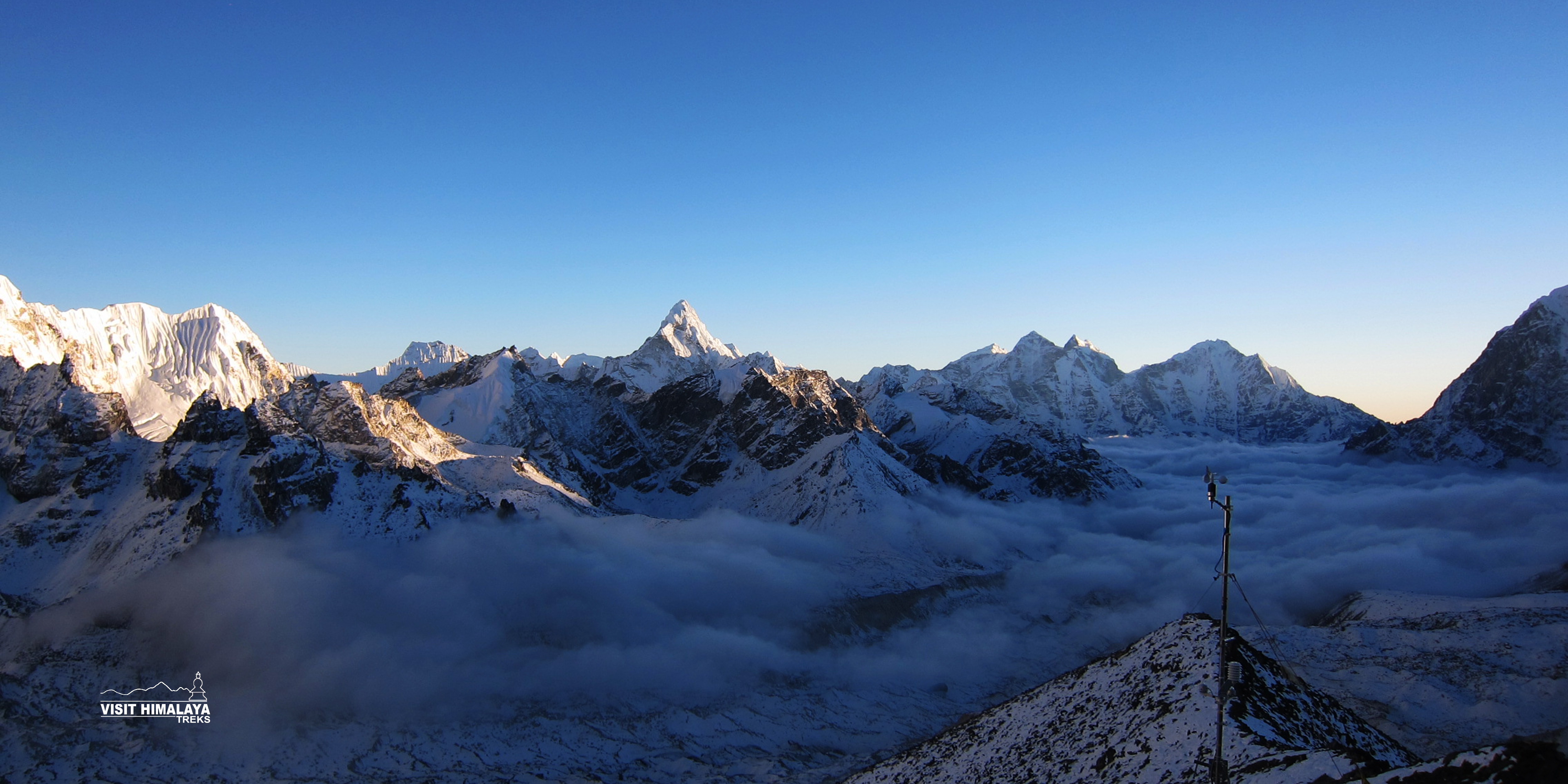
Everest Three Passes Trek's Trip Fact
|
Maximum Elevation:
|
5545 meters, Kala Patthar
|
|
Trek Duration:
|
22 Days
|
|
Trek Difficulty:
|
Demanding +
|
|
Accommodation Type:
|
Teahouse
|
|
Best Season:
|
March-May, and October- November
|
|
Restricted Area:
|
No
|
|
Require Trekking Permits
|
Sagarmatha National Park entry permits & Pasang Lamu municipality entry permits.
|
|
Starting Point / Ending Point
|
Lukla
|
Everest Three Passes Trek's Highlight:
- Crossing three high mountain passes Kongma La Pass, Cho La Pass, and Renjo La Pass.
- Spectacular views of Everest, Lhotse, Makalu, and other towering peaks.
- Exploring remote valleys, glacial lakes, and traditional Sherpa villages.
- Immersion in the unique culture, traditions, and monasteries of the region.
Everest Three Pass Trek's Altitude Profile
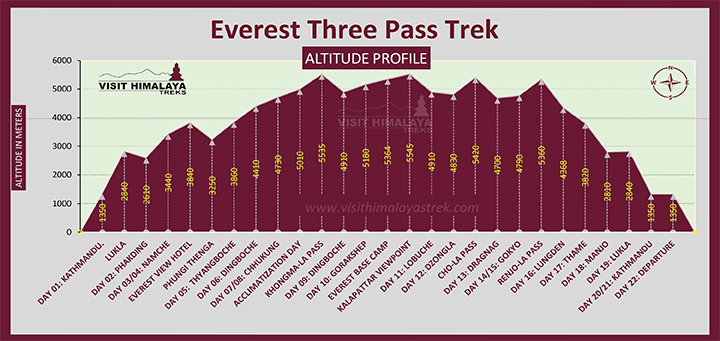
The Everest Three Passes Trekking is another popular and adventurous destination for treks in Nepal within the Everest region. It includes the renowned Renjo-La, Cho-La, and Kongma-La passes, as well as picturesque views of the world's highest mountains, the Khumbu Glacier, and unique settlements at high altitudes.
The Everest Region, also known as the Sagarmatha National Park, is famous for its Sherpa villages, including Lukla, Namche, Khumjung, Thame, and Pangboche. Monasteries and cultural museums are popular attractions and serve as spiritual centers for the Sherpa community.Khumbu region offers numerous trekking trails, ranging from moderate to strenuous. The Everest Three Passes Trek is considered one of the most exhilarating and demanding treks in Nepal. Ascending three difficult passes, Kongma La, Cho La, and Renjo La, provide stunning views of the Himalayas from various perspectives. This trek allows you to explore the hidden corners of the Everest region.
The Three Passes Trek in the Everest Region is an ideal adventure for those who have ample time and want to fully experience the area. This trek involves crossing three passes above 5,000 meters, namely Renjo La, Cho La, and Kongma La and offers even more breathtaking views of the majestic Himalayan mountains compared to the Everest Base Camp Trek. It can also be combined with other variations of the Everest Base Camp Trek.
Considered the ultimate trek for thrill-seekers and adventurers, the Everest Three High Passes Trek allows you to not only reach Everest Base Camp but also traverse the three highest passes in the Khumbu region: Kongma La Pass, Cho La Pass, and Renjo La Pass. This trek offers a unique opportunity to explore the entire Everest Region from various angles, including the bustling route leading to Everest Base Camp, the charming Gokyo Valley, and the rustic Thame Valley.
Ranked as the second-best trek in Nepal by Travellers, the Three Passes Trek is known for its challenging nature and stunning scenery. With a duration of 22 days, it is the longest and toughest trek in Nepal, recommended for experienced trekkers seeking a rewarding adventure. Along the trail, you will conquer three peaks: Gokyo Ri, Kala Patar, and Chukhung Ri.
Starting from the Bhote Kosi Valley, the trek crosses the Renjo La Pass into the Gokyo Valley, where you can explore the beautiful emerald lakes. It then proceeds over the Cho La Pass into the Dudh Kosi Valley and finally ascends to Everest Base Camp. The journey concludes by crossing the Kongma La Pass and reaching the Imja Khola Valley. Throughout the trek, you will witness breathtaking landscapes and have the opportunity to submit impressive peaks.
The Everest Three Passes Trek is recommended for dedicated trekkers seeking a challenging adventure in the Khumbu region. It offers a unique opportunity to escape the crowds and fully immerse yourself in the mountains while exploring the Everest Region from different perspectives.
It's important to note that the three passes come with risks, and this trek should not be taken lightly. Proper physical preparation and psychological determination are essential. It is crucial to avoid attempting the passes if you are not feeling fully fit. Also if the weather conditions are unfavorable, and especially not alone.
Ideal for adventure enthusiasts, the Everest Three Passes Trek will test your endurance in the Himalayas. The trail takes you through dense forests, showcasing the rich vegetation of the region, before transitioning into the alpine zone with rocky and snowy terrain.
Annapurna Circuit Trek - The World's Popular Treks to Annapurna region of Nepal.
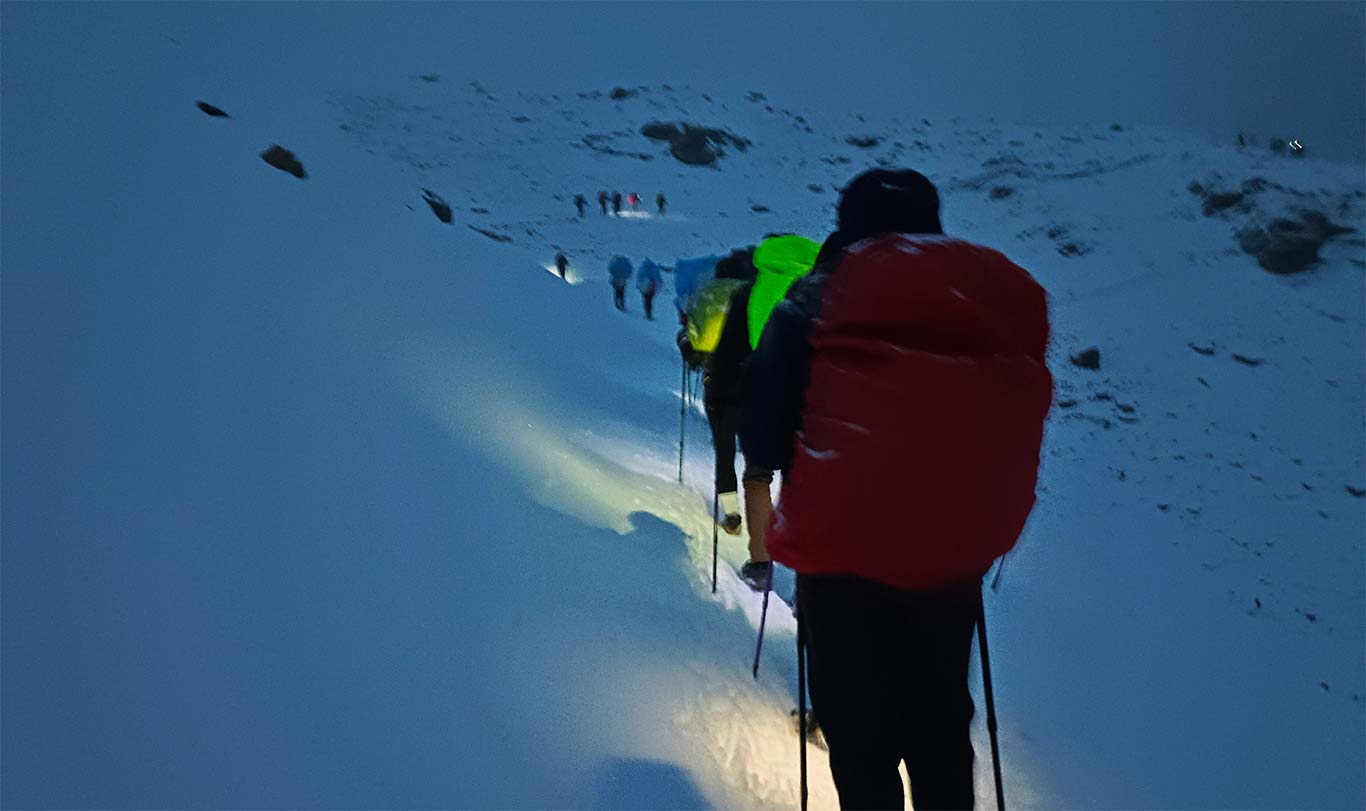
Annapurna Circuit Trek's Trip Fact
|
Maximum Elevation:
|
5416 meters, Thorong La Pass
|
|
Trek Duration:
|
15 days
|
|
Trek Difficulty:
|
Demanding
|
|
Accommodation Type:
|
Teahouse
|
|
Best Season:
|
March-May, and October- November
|
|
Restricted Area:
|
No
|
|
Required Trekking Permits:
|
Annapurna Conservation Area (ACAP) Entry Permits Trekkers Information management system (TIMS) Card
|
|
Starting/ Ending Point :
|
Dharapani/ Ghandruk
|
Annapurna Circuit Trek's Highlight:
- A classic trek is known for its diverse landscapes and breathtaking mountain views.
- Crossing the Thorong La Pass, one of the world's highest trekking passes.
- Passing through picturesque villages, terraced fields, and rhododendron forests.
- Experiencing the cultural diversity of the region, including encounters with Gurung and Thakali communities.
Annapurna Circuit Trek's Altitude Profile
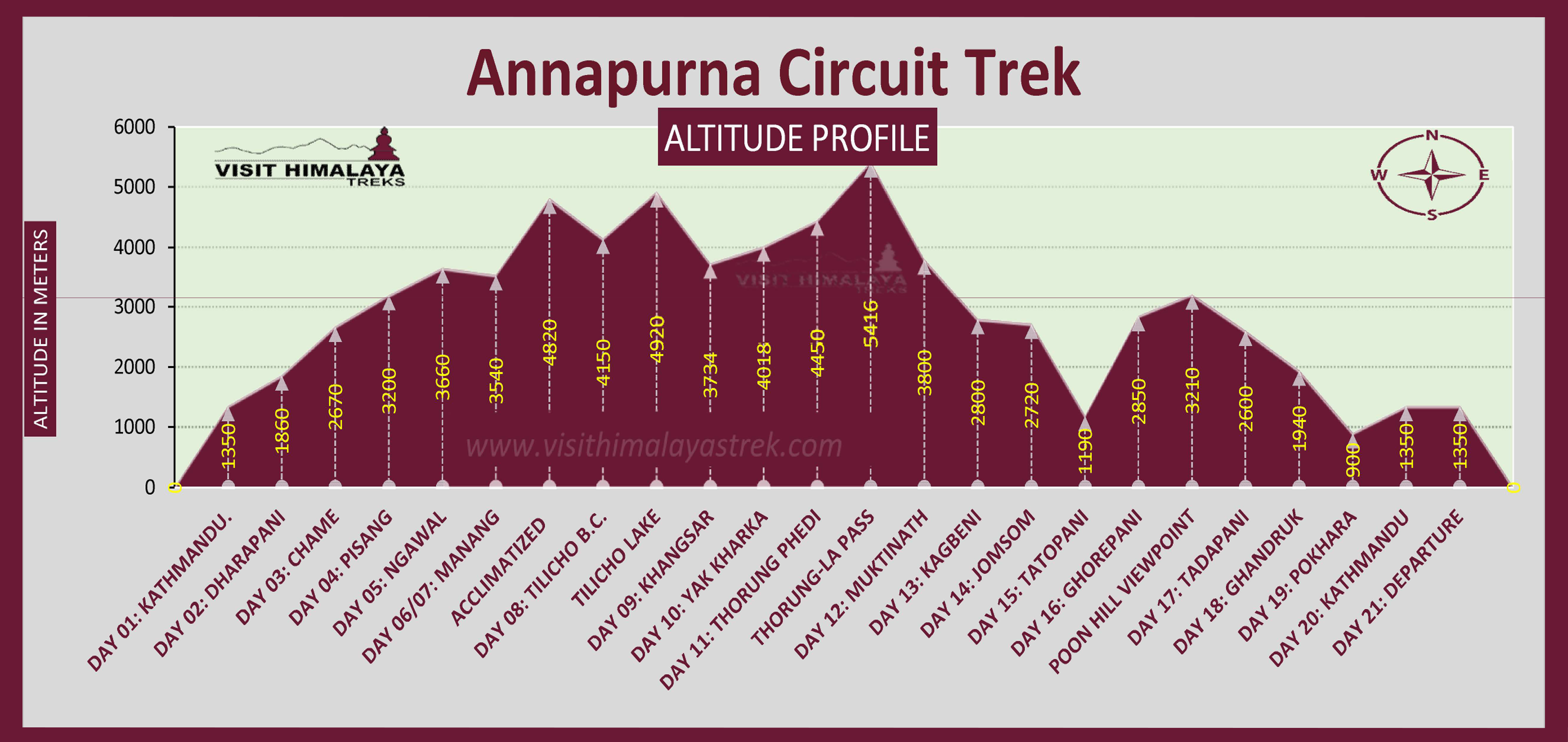
Experience the awe-inspiring 21 Days Annapurna Circuit trek, renowned as one of the world's greatest treks. Definitely, it should be on the list of Best destinations for Treks in Nepal. This extraordinary journey takes you through a range of landscapes, from lush subtropical forests and fertile paddy fields to icy glaciers, a formidable mountain pass, rugged cliffs, and panoramic mountain vistas.
Immerse yourself in the breathtaking beauty of the Nepalese Himalayas as you traverse the snow-capped peaks, mist-covered valleys, secluded communities, and remote monasteries. With altitudes exceeding 5000 meters, you'll discover the rich ancestral traditions of the local people and fully immerse yourself in the mesmerizing mountain wilderness of the Annapurna Circuit. While the trek is challenging, the sense of accomplishment and the creation of unforgettable memories make it worthwhile for even the most experienced hiker.
Starting from Manang, the trek treats you to views of the majestic Manaslu range, traditional Tibetan-style Buddhist villages, and verdant woodlands as you make your way through the Marshyangdi Valley. As you approach the lofty Thorong La Pass, a panorama of mountains unfolds before your eyes, including the Annapurna Massif, Dhaulagiri, Manaslu, and Tilicho Peak.
Continuing your journey beyond the pass, you enter Mustang and encounter the Hindu pilgrimage site of Muktinath, with its temple and 108 waterspouts. Descending into the Kali Gandaki Valley, you'll pass through the captivating village of Marpha, known for its quaint monastery, narrow cobblestone streets, and flourishing apple orchards. Further along, you'll have the opportunity to relax in the rejuvenating hot springs of Tatopani and marvel at the breathtaking vistas from Poon Hill.
From the vantage point of Poon Hill, you can feast your eyes on more than 20 of the highest peaks in the Annapurna and Dhaulagiri ranges. This trek provides ample time for acclimatization before tackling the formidable Thorong La pass, which stands at an elevation of 5,414 meters. While it's a demanding journey, having a reasonable level of physical fitness is recommended.
With its diverse landscapes, captivating villages, and the majestic allure of the mountains, the Annapurna Circuit presents a photographer's paradise. It also offers a comprehensive exploration of Nepal's various cultures, landscapes, and facets, all while circumnavigating the stunning Annapurna range. The holy temple and 108 waterspouts of Muktinath hold great significance for Hindus and add to Nepal's cultural heritage. A short hike from the trail leads you to the villages of Jharkot and Kagbeni, immersing you in a Buddhist culture of monasteries and fluttering prayer flags.
Kagbeni, a charming village, serves as a gateway to Upper Mustang. And you'll encounter numerous yak and mule caravans transporting goods northward. As you explore the quaint village, you'll discover intriguing sights such as ancient clay effigies. This trek offers a diverse and captivating experience, filled with daily surprises and enchanting encounters, all accompanied by up-close and personal mountain vistas. The Annapurna Circuit ranks among the top treks in Nepal and the world, offering an incredibly diverse and stunning journey.
Annapurna Base Camp Trek - The Trek for Everyone
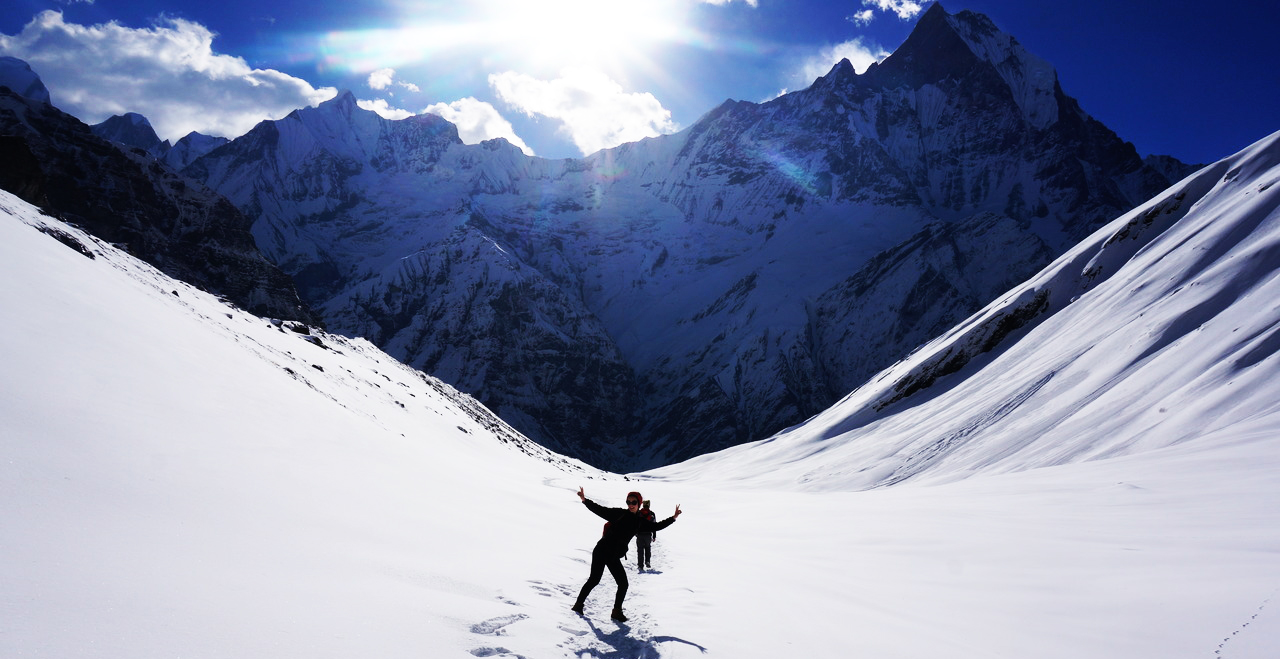
Annapurna Base Camp Trek's Fact:
|
Maximum Elevation:
|
4130 Annapurna Base Camp
|
|
Trek Duration:
|
14 Days
|
|
Trek Difficulty:
|
Moderate
|
|
Accommodation Type:
|
Teahouse
|
|
Best Season:
|
March-May, and October- November
|
|
Restricted Area:
|
No
|
|
Required Trekking Permits
|
Annapurna Conservation Area (ACAP) Entry Permits Trekkers Information management system (TIMS) Card
|
|
Starting/ Ending Point :
|
Hile / Siwai
|
Annapurna Base Camp Trek's Highlight:
- Journeying to the base camp of the majestic Annapurna massif.
- Close-up views of Annapurna I, Machapuchare (Fishtail), and other peaks.
- Walking through bamboo and rhododendron forests, and crossing suspension bridges.
- Discovering the rich biodiversity of the Annapurna Conservation Area.
Annapurna Base Camp Trek's Altitude Profile:
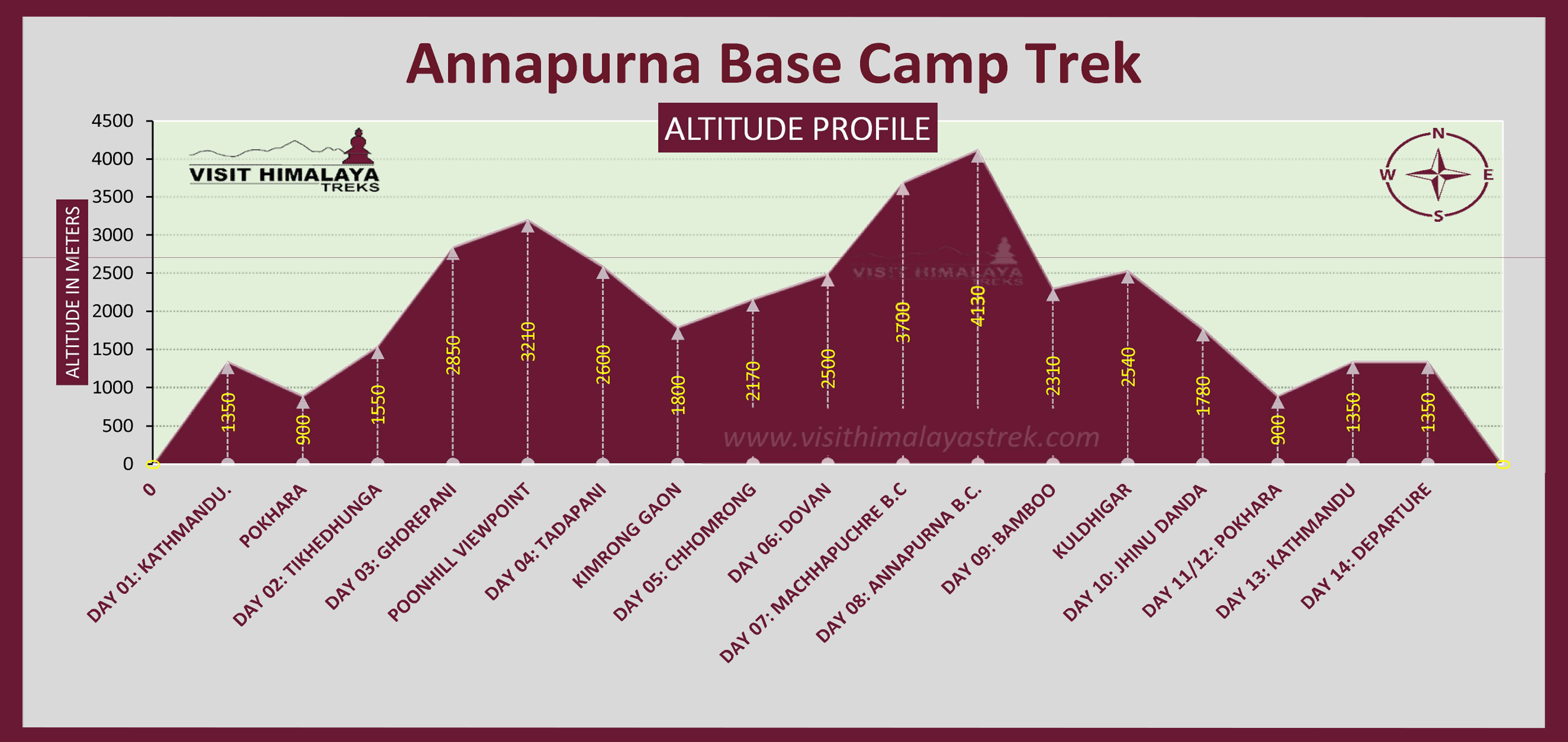
Another highly recommended best Trek in Nepal, the ABC Trek. This region boasts an exceptional variety of flora and fauna, including pine trees, wildlife, various bird species, reptiles, and more. The Annapurna Base Camp, situated within the Annapurna Conservation Area Project (ACAP), is a captivating land teeming with biodiversity. The primary objective of ACAP is to strike a balance between environmental conservation and socio-economic development through active community participation. This project is supported by the National Trust for Nature and showcases stunning natural beauty and multicultural communities.
You have three optional routes to embark on the Annapurna Base Camp Trek. The first route starts from Nayapul and continues through Ghorepani (Poon Hill), covering a total of 14 days. The second route begins directly from Nayapul to ABC and takes 7 days. The third option is the 10-day Annapurna Base Camp Trek, commencing from Dhampus or Kade. For many travelers, the Annapurna Base Camp Trek serves as a shorter and more affordable alternative to the Everest Base Camp trek. The base camp is surrounded by some of the world's highest peaks, including Annapurna I, Annapurna South, Machapuchhre, and Hiunchuli. Depending on your chosen route, the trek's duration ranges from 6 to 14 days.
With the highest point of the trek at Annapurna Base Camp, situated at 4,130 meters, there is only one night spent at a high altitude, reducing the risk of altitude-related illnesses. This makes the Annapurna Base Camp Trek a safe and feasible option throughout the year. Which is why it's in the list of Best Treks in Nepal. Visiting the Annapurna Base Camp is an extraordinary experience that should not be missed. It is considered one of the best treks in Nepal, offering breathtaking views of the majestic Himalayas. The journey commences with a scenic drive from Kathmandu to Pokhara, followed by daily progress toward the Annapurna Base Camp. After Everest Base Camp Trek, ABC is the second most popular trekking destination in Nepal.
The Annapurna Base Camp Trek presents a wide range of natural wonders. As you traverse the route, you will be captivated by the stunning landscapes, terraced fields, Gurung villages, and diverse flora and fauna. Mount Annapurna, the 10th highest mountain in the world, stands prominently at 8,091 meters. The trek takes you through a lateral distance of approximately 60-70 kilometers, encompassing peaks over 8,000 meters.
The captivating scenery of the Annapurna region offers awe-inspiring views, especially during the early morning when the mountains appear majestic and the sunrise paints the sky with breathtaking colors. The trek provides a close encounter with the base of 7,000-meter and 8,000-meter peaks, offering a sense of grandeur and magnificence.
Renowned as a legendary and classic trek in Nepal, the Annapurna Base Camp Trek let's you encounter the rich cultural diversity of the region, passing through remote farms and villages inhabited by the Gurung ethnic group. The Gurung people are renowned worldwide for their bravery and you will have the opportunity to experience their culture, ancient traditions, and religious values.
The 14-day Annapurna Base Camp Trek begins with a drive from Pokhara to Nayapul, followed by a trek along the riverside trail to Birethanti. The journey continues to Jhinu Danda, where you can relax in the hot springs, and then proceeds to Dovan, offering mesmerizing views of Mount Machhapuchhre, Annapurna South, and Huinchuli. Passing through Chomrong, a large Gurung village, you will explore bamboo and rhododendron forests beside the Modi River until you reach Annapurna Base Camp, situated at an elevation of 4,095 meters. Machhapuchhre Base Camp, nestled on the northern side of the majestic Mount Machhapuchhre, is an enchanting destination on the way.
Trekking in the Annapurna is a must-do activity for anyone who is searching for the best destination for treks in Nepal.
Annapurna Community Lodge Trek - Experience the real Authentic culture and lifestyle.
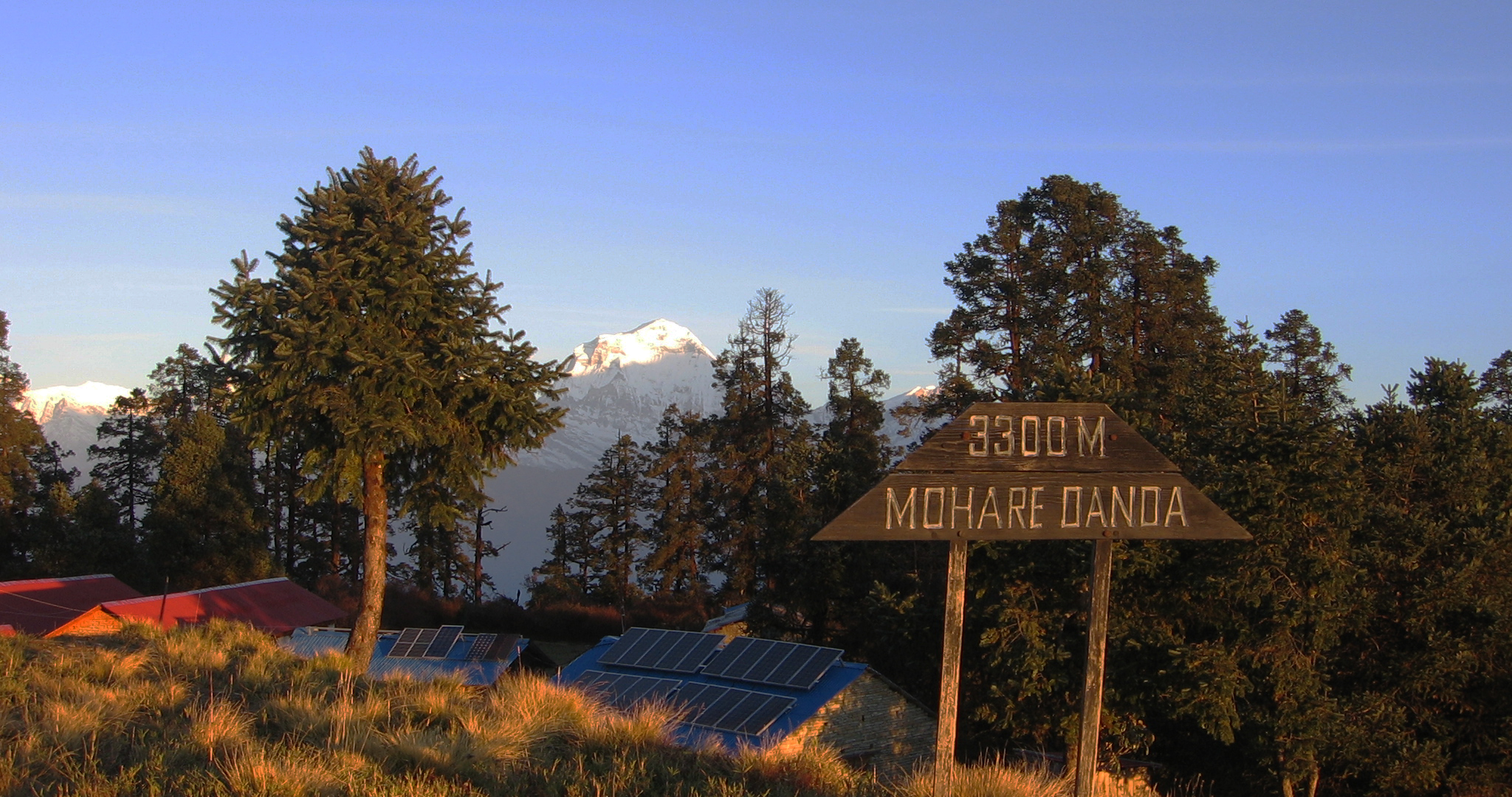
Annapurna Community Lodge Trek's Fact
|
Maximum Elevation:
|
3660 Meters Khopra
|
|
Trek Duration:
|
18 Days
|
|
Trek Difficulty:
|
Moderate
|
|
Accommodation Type:
|
Teahouse
|
|
Best Season:
|
March-May, and October- November
|
|
Restricted Area:
|
No
|
|
Required Trekking Permits
|
Annapurna Conservation Area (ACAP) Entry Permits Trekkers Information management system (TIMS) Card
|
|
Starting / Ending Point :
|
Beni / Ghandruk
|
Annapurna Community Lodge Trek's Highlight
- Immersion in the local culture and hospitality by staying at community-managed lodges.
- Exploring lesser-known trails and villages, away from the main trekking routes.
- Witnessing traditional farming practices and interacting with local communities.
- Enjoying panoramic views of the Annapurna and Dhaulagiri mountain ranges.
Annapurna Community Lodge Trek's Highlight
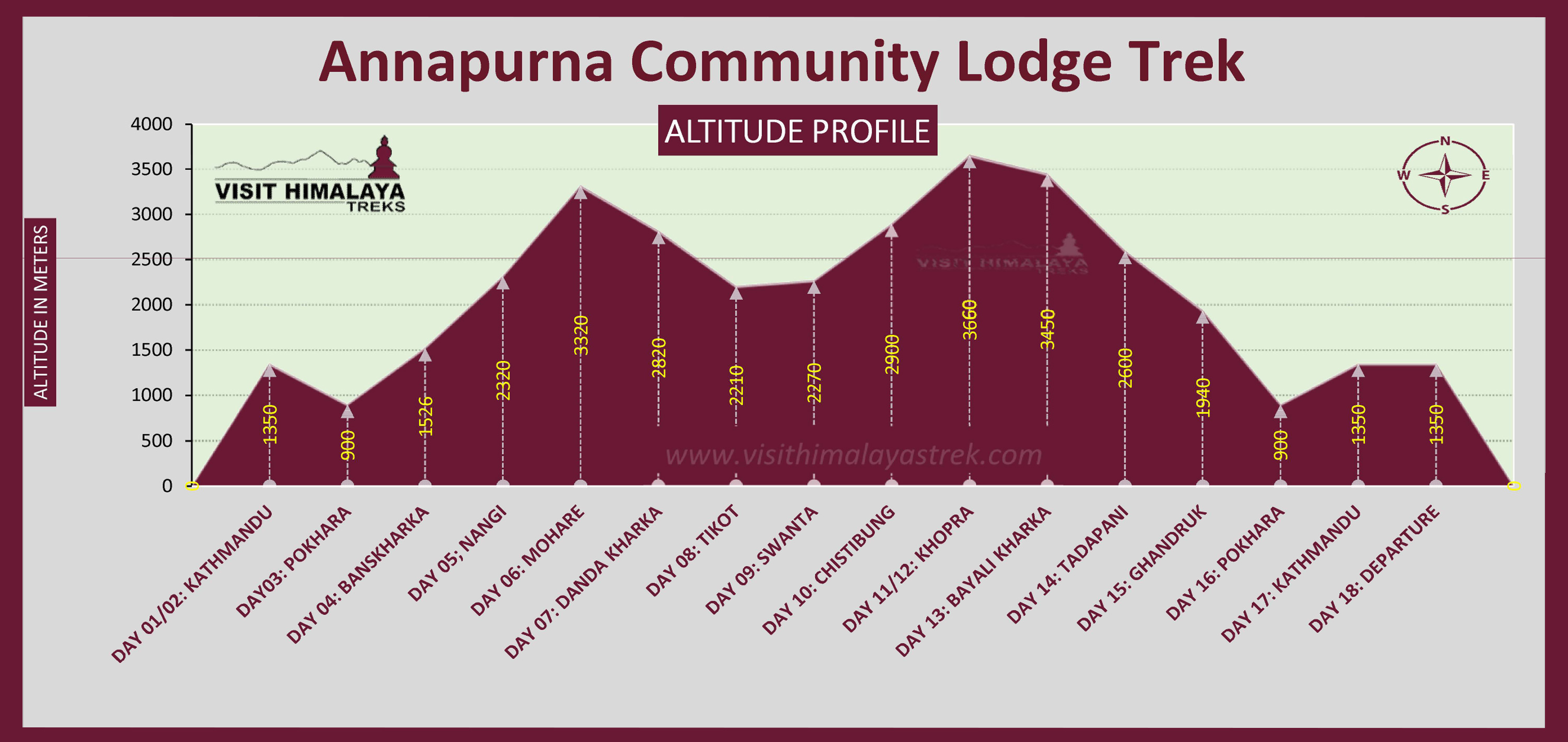
The Annapurna Community Lodge Trek, also known as the Annapurna and Dhaulagiri Community Trail Trek or Mohare Danda Trek, takes you on a journey through rural communities in the Annapurna and Dhaulagiri Region, where you can stay in community lodges. This trek provides an incredible experience that combines abundant natural beauty with rich cultural immersion. The breathtaking views from Khopra, the highest point of the trek at 3650 meters, rival or even surpass those from Poon Hill.
Moreover, the warm encounters with the friendly villagers will undoubtedly leave you wanting to come back for more. There is a common saying that individuals visit Nepal for its mountains but find themselves drawn back for its people. If you're excited to have an amazing experience and witness the best views of the Himalayas, the two high points of Mohare and Khopra will undoubtedly fulfill your expectations. Another unique advantage of this trek is the opportunity to encounter yaks, as Khopra Ridge is the only place in the Annapurnas where they can be found, along with a yak farm.
This "Off The Beaten Path" trek takes you through captivating Rhododendron forests, unveiling hidden Hindu temples and shrines nestled amidst peaceful lakes. The Annapurna Dhaulagiri Community Trail Trek offers abundant and awe-inspiring views of majestic mountains. Additionally, it provides a wonderful chance to engage with the Magar culture and traditions by visiting yak farms, cheese mongers, local paper makers, forest nurseries, or bhangra tailors.
Nar Phu Valley Trek - Trek in Hidden valley of Naar and Phu.
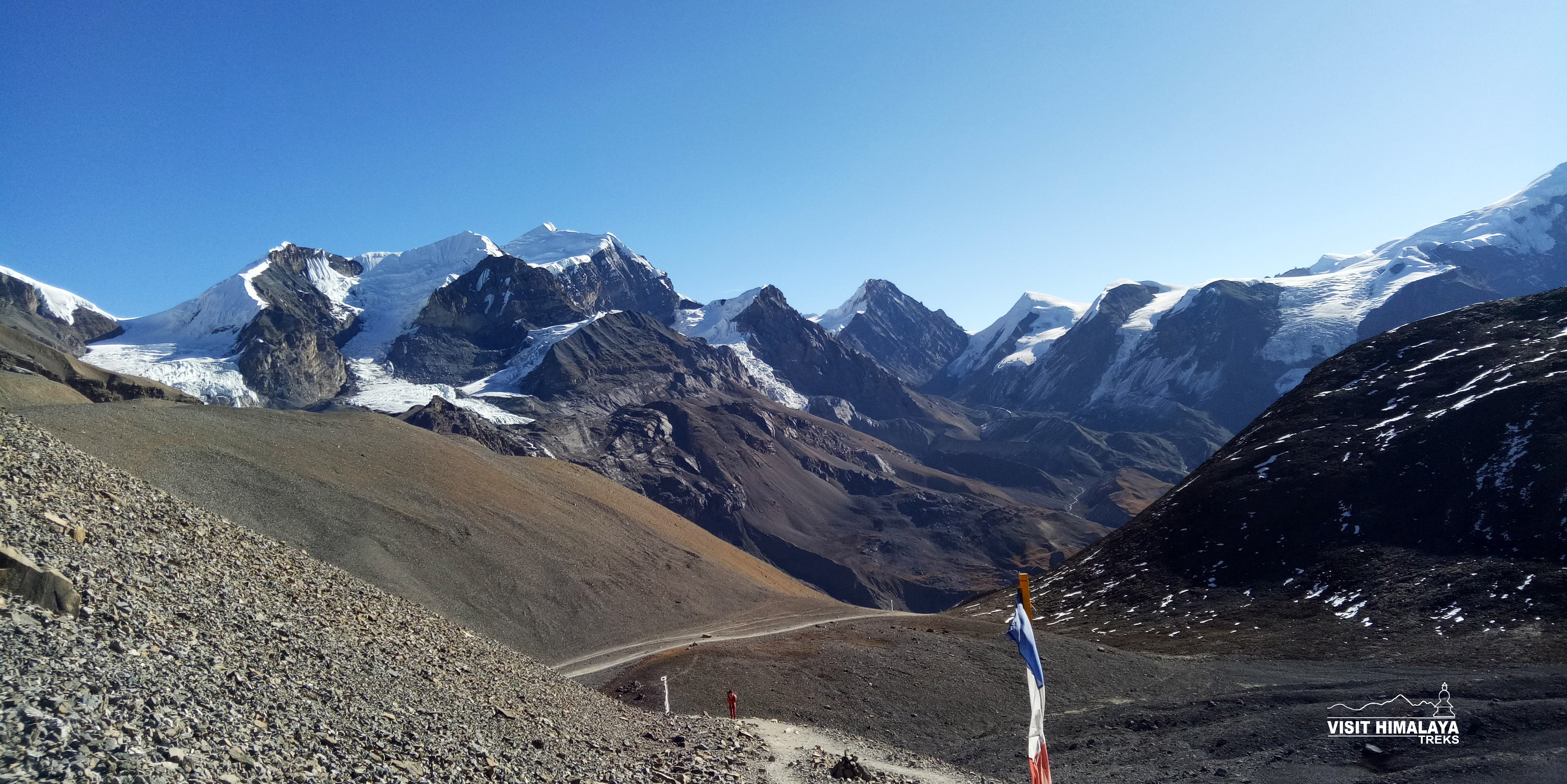
Nar Phu Valley Trek's Trip Fact
|
Maximum Elevation:
|
5320 meters, Kang-La Pass
|
|
Trek Duration:
|
13 days
|
|
Best Season:
|
March-May, and October- November
|
|
Trek Difficulty:
|
Demanding
|
|
Accommodation Type:
|
Teahouse
|
|
Restricted Area:
|
Yes
|
|
Require Trekking Permits:
|
Nar Phu Valley restricted area entry permits. Annapurna Conservation Area (ACAP) Entry Permits. Trekkers Information management system (TIMS) Card.
|
|
Starting / Ending Point :
|
Koto / Chame
|
Nar Phu Valley Trek's Fact
- Off-the-beaten-path trek in the remote Nar and Phu valleys.
- Exploring ancient Tibetan-influenced villages and monasteries.
- Spectacular landscapes, including deep gorges, narrow canyons, and snow-capped peaks.
- Rich cultural experience with the local Nar and Phu inhabitants.
Nar Phu Valley Trek's Altitude Profile
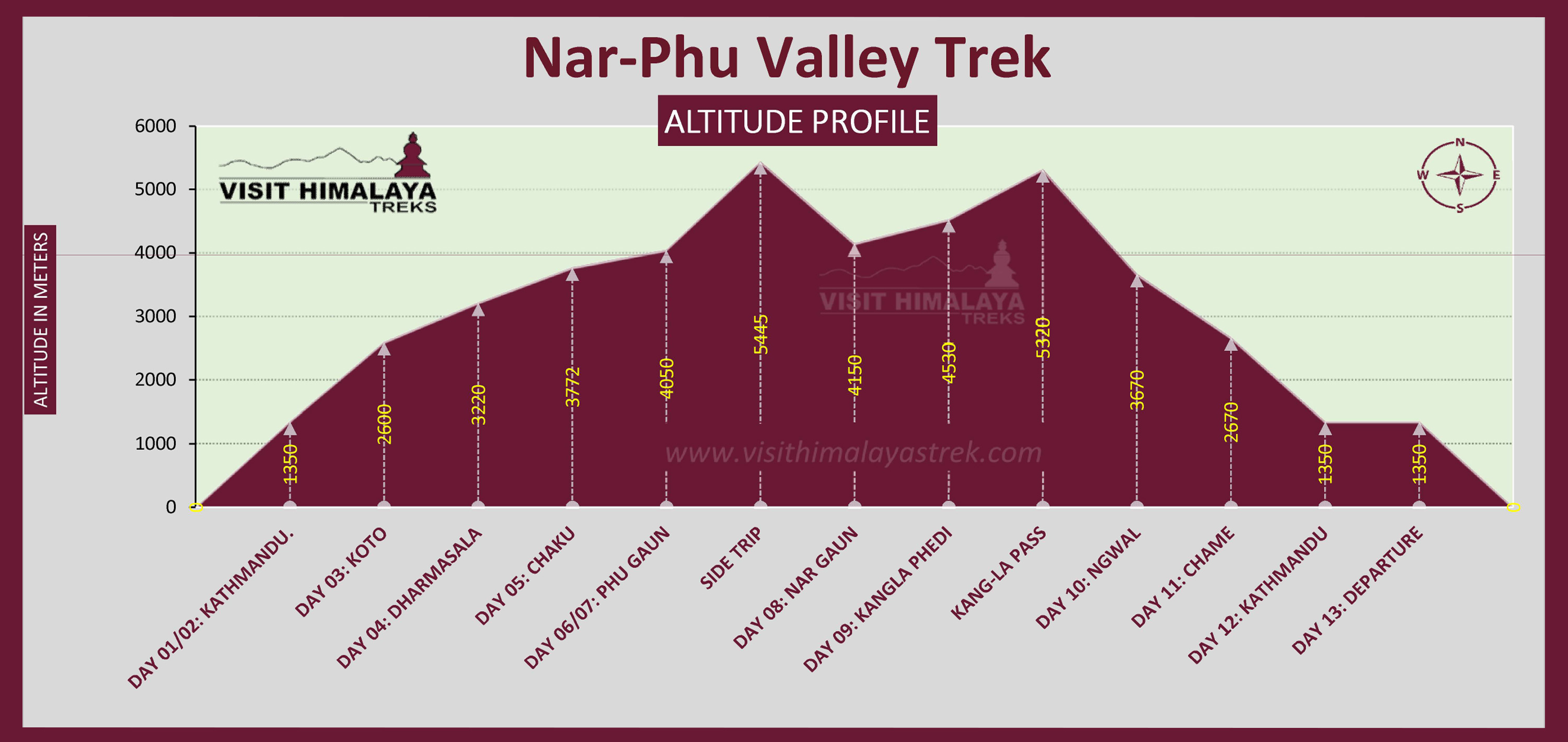
The Nar Phu Valley trek offers a unique and off-the-beaten-path experience in the Annapurna region. Previously undiscovered by many trekkers, this hidden valley is located in the northwest and was restricted until 2002. It was considered inconvenient to visit due to limited food and accommodation facilities. However, with its rich cultural heritage, nomadic landscapes, and challenging Kang La Pass, the trek has gained popularity over time. This is why, It's one of the best destinations for Treks in Nepal.
The Nar Phu Valley trek provides a combination of breathtaking landscapes, high peaks, glaciers, remote villages, narrow canyons, lush forests, unique rock formations, yaks, Buddhist Gompas, and the fusion of traditional Bon-Po religion and Mahayana Buddhism. It is a hidden treasure nestled in the Himalayas, inhabited by Tibetan-origin groups who have preserved their cultural traditions for generations. The journey begins in Jagat and follows the popular Annapurna Circuit trail before branching off to the Nar Phu Valley. The trek passes through picturesque villages, crosses the Kang La Pass, and eventually joins the Annapurna Circuit trail again. The trek can be physically demanding, requiring a good fitness level and prior trekking experience.
The Nar Phu Valley is a remote and untouched region, offering a peaceful escape from the tourist crowds that often flock to the neighboring Annapurna Circuit. The trek provides an opportunity to witness pristine natural beauty, Tibetan-like cultures, and ancient traditions. The route also offers panoramic views of majestic Himalayan peaks such as Manaslu, Dhaulagiri, and Annapurna I. As you trek through the Nar Phu Valley, you will have the chance to interact with the local communities and learn about their unique way of life.
The farmers in this region rely on traditional agricultural practices, cultivating crops such as potatoes, barley, buckwheat, and vegetables, while also raising yaks and sheep. The Nar Phu Valley trek is a relatively short yet captivating journey in the Trans-Himalayan region, which is located behind the north face of Mount Annapurna. It combines adventure, cultural exploration, and stunning scenery. The trail follows the Nar Khola River, passing through forests and offering occasional glimpses of magnificent mountain views. The trek includes visits to colorful Tibetan chortens, monasteries, rock paintings, and vast pasturelands.
The villages of Phu and Nar are particularly captivating, showcasing a preserved Tibetan culture and captivating architectural structures. Additional side trips to Himlung Himal Base Camp, Tashi Khaling Gumba, and Damodar Kunda can also be arranged. The Nar Phu Valley trek is a rewarding and budget-friendly option for those seeking off-the-beaten-track adventurous treks in Nepal. It is recommended to undertake this trek during the autumn or spring seasons for the best weather conditions.
Upper Mustang Trek - Trek to the Forbidden Kingdom in Upper Mustang.
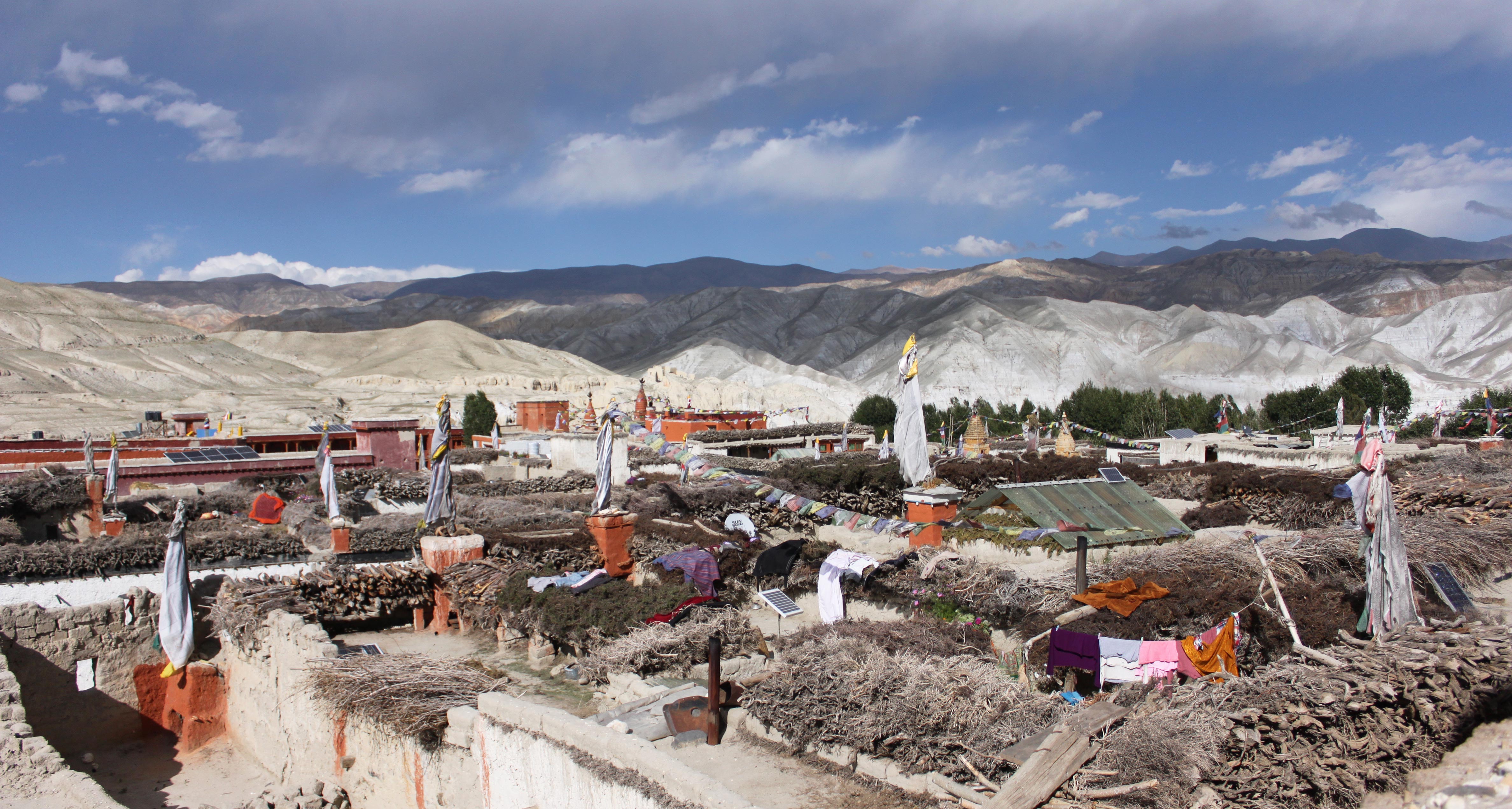
Upper Mustang Trek's Trip Fact.
|
Maximum Elevation:
|
3,810 meters, Dhakmar
|
|
Trek Duration:
|
20 days
|
|
Best Season:
|
March to November
|
|
Trek difficult:
|
Moderate
|
|
Accommodation Type:
|
Teahouse
|
|
Restricted Area:
|
Yes
|
|
Require Trekking Permits:
|
Upper Mustang Restricted area entry permits. Annapurna Conservation Area (ACAP) Entry Permits. Trekkers Information management system (TIMS) Card.
|
|
Starting / Ending Point:
|
Jomsom
|
Upper Mustang Trek's Highlight:
- Trekking in the ancient and isolated region of Upper Mustang.
- Exploring the medieval walled city of Lo Manthang, with its unique Tibetan culture.
- Passing through barren landscapes, dramatic cliffs, and eroded rock formations.
- Visiting ancient Buddhist monasteries and experiencing the Trans-Himalayan culture.
Upper Mustang Trek's Altitude Profile
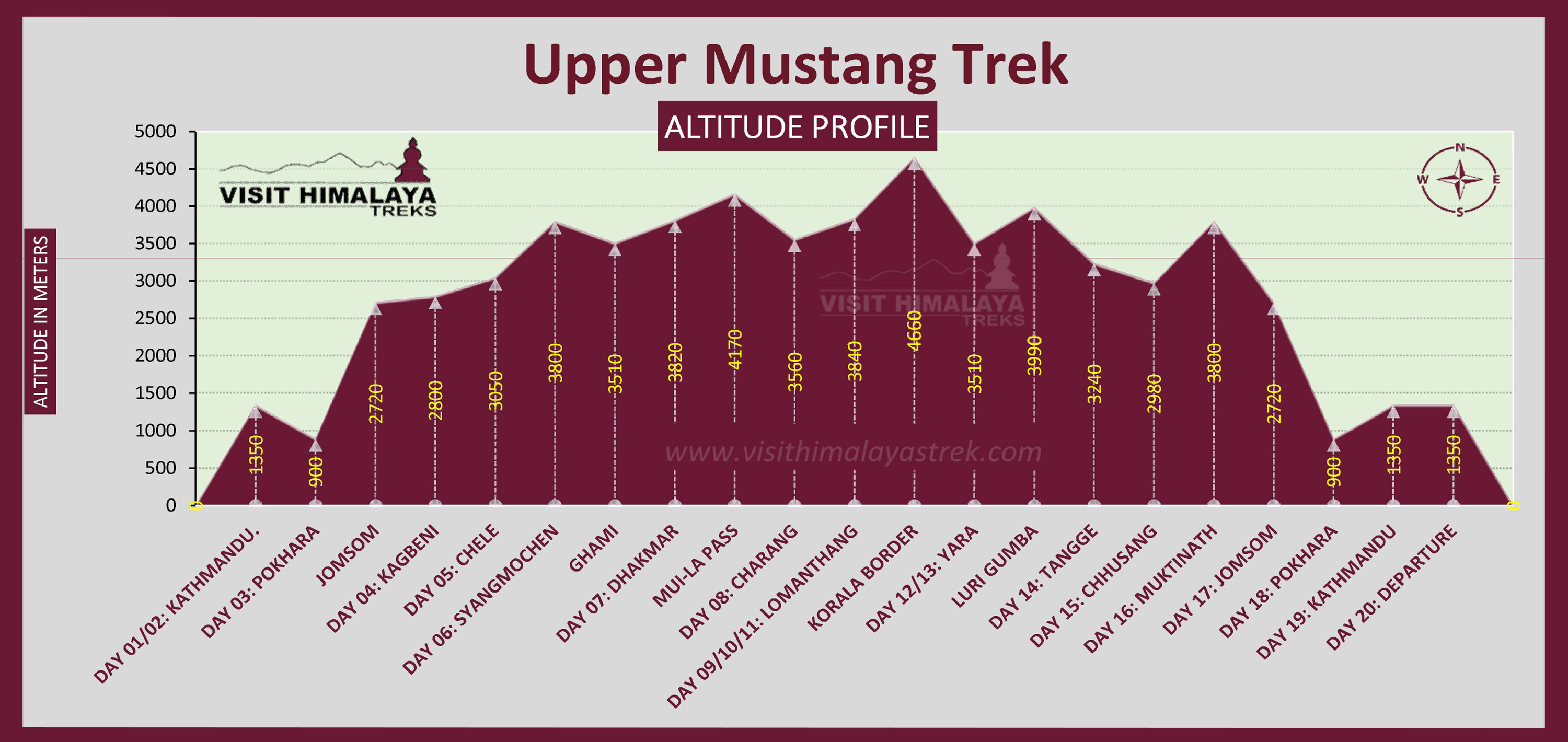
Embarking on one the best treks in Nepal through the restricted area of Upper Mustang, tracing the ancient salt route, guarantees an unforgettable adventure. Referred to as the "Last Forbidden Kingdom," this region was inaccessible to all but a few until 1992. Immerse yourself in the undisturbed Tibetan Buddhist culture, as you encounter ancient monasteries, traditional villages, cliffside cave dwellings, and the impressive architecture of Lo Manthang, the walled capital of the Mustang region.
Commonly known as Mustang, this arid region resembles Tibet and is situated at the northern end of the Kali Gandaki River. With a rich and intricate history, Mustang has become one of Nepal's most captivating destinations. Its roots trace back to the 8th century, and it is believed that the Tibetan poet Milarepa may have visited the area. The Mustang countryside bears a resemblance to the Tibetan plateau, featuring vast expanses of yellow and grey rolling hills sculpted by wind erosion. In the lower regions of Upper Mustang, rainfall is more prevalent, resulting in red-fluted cliffs composed of small round stones held together by mud. Villages are scattered hours apart, appearing like mirages in the distance. While in the summer season transforms them into green oases amidst the desert-like landscape.
The Upper Mustang trek offers a glimpse into the region's essence and beauty, showcasing ancient caves, majestic mountains, traditional villages, and religious landmarks such as chortens, mani walls, and ruins of ancient palaces. This remote area provides an opportunity to witness the untouched Tibetan Buddhist culture, experience the warm hospitality of local tea houses, and immerse yourself in the traditional way of life.
The journey commences with a scenic bus ride from Kathmandu to Pokhara, followed by a picturesque flight from Pokhara to Jomsom. From Jomsom, the trek takes you through Kagbeni, Chele, Syangboche, Ghami, Tsaran, and finally to the ancient kingdom of Lo Manthang. After exploring Lo Manthang, the return journey follows the same path, passing through Dhamkar, Chussang, and concluding in Jomsom. The trek concludes with a return flight from Jomsom to Pokhara and a bus ride back to Kathmandu.
The actual trek commences at Kagbeni, the gateway to Upper Mustang, leading you through a stark landscape shielded from the rain by the Dhaulagiri massif until you reach Lo-Manthang, the historical seat of the Kingdom of Lo's past Kings. Along the way, you can explore caves, rock paintings, monasteries, and gompas, gaining profound insights into the local culture. The trek also offers panoramic views of majestic mountains such as Nilgiri, Annapurna, and Dhaulagiri, intensifying the thrill of the journey.
Lo Manthang itself offers opportunities to explore cultural sites such as Namgyal Gompa, Tingkhar (the final major village in the northwest), and the King's palace, which enhance the cultural experience. Additionally, there is an Amchi museum and school where visitors can delve into the ancient healing practices of traditional Tibetan medicine and its relevance in contemporary times.
A few hours' walk from Lo Manthang, you'll discover Gyakar. It's renowned for its ancient Gompa which dates back over 1,200 years and is dedicated to Guru Rinpoche. The Gompa is famous for its rock paintings, and there is a belief that making a wish there will make it come true, adding intrigue to your journey.
The trek takes place at relatively high altitudes ranging from 3,000m to 3,800m, and the dry air intensifies the effects of altitude. While individuals born at such altitudes can travel at a fast pace, visitors are advised to hike leisurely to avoid altitude-related issues. On average, daily walking takes 5 to 7 hours, and some paths can be windy and dusty.
Manaslu Circuit Trek - Trek Around Majestic Mt. Manaslu Over Larkya la Pass.
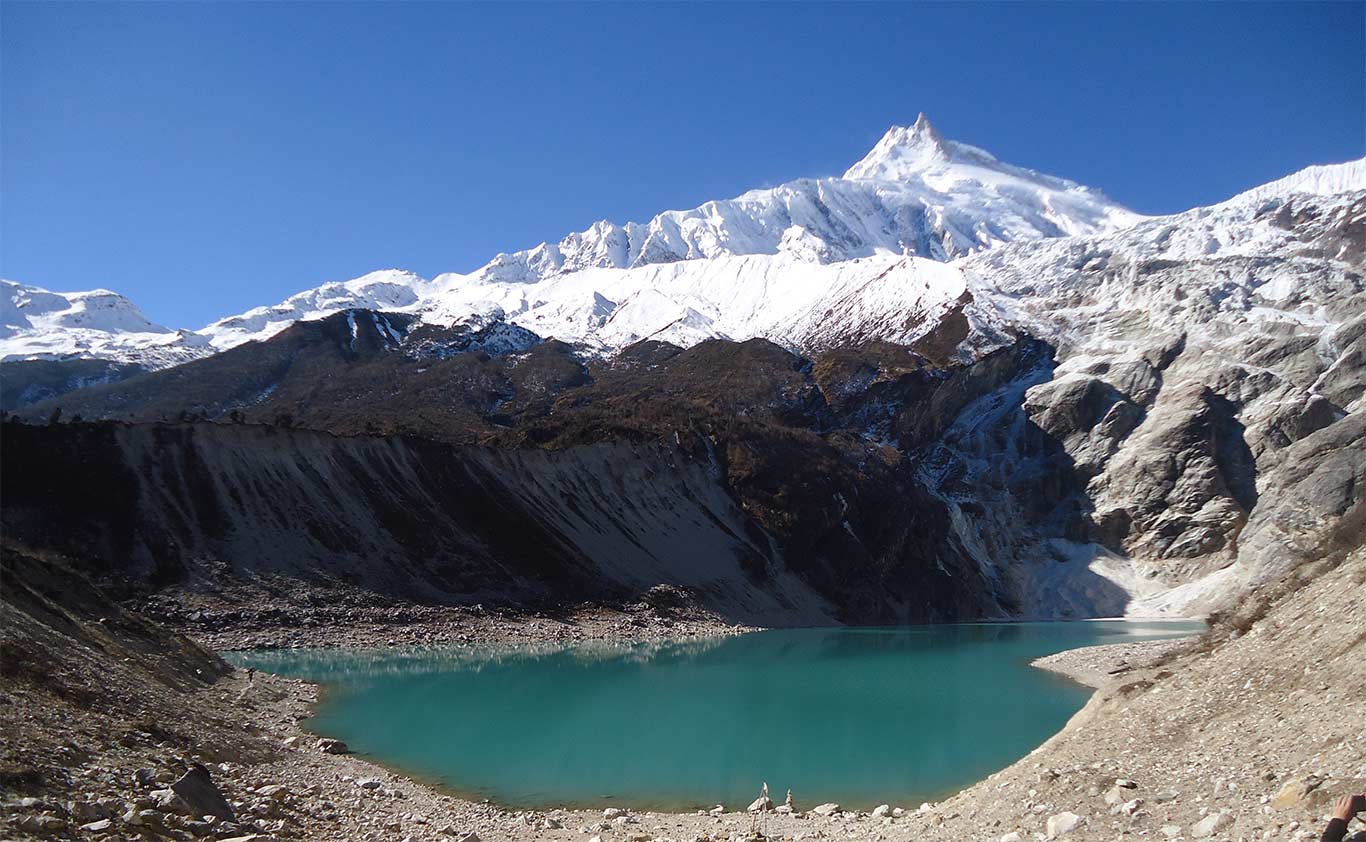
Manaslu Circuit Trek's Trip Fact
|
Maximum Elevation:
|
5106 meters, Larkya Pass
|
|
Trek Duration:
|
18 days
|
|
Best Season:
|
March-May, and October- November
|
|
Trek difficult:
|
Demanding
|
|
Accommodation Type:
|
Teahouse
|
|
Restricted Area:
|
Yes
|
|
Require Trekking Permits:
|
Manaslu Restricted area entry permits.Manaslu Conservation Area (MCAP) Entry PermitsAnnapurna Conservation Area (ACAP) Entry Permits.Trekkers Information management system (TIMS) Card.
|
|
Starting / Ending Point:
|
Barpak / Dharapani
|
Manaslu Circuit Trek's Highlights:
- Trekking around the majestic Manaslu, the eighth-highest peak in the world.
- Crossing the challenging Larkya La Pass with panoramic views of Manaslu and surrounding peaks.
- Immersion in the diverse culture and traditions of the ethnic communities in the region.
- Scenic beauty, including waterfalls, terraced fields, and rhododendron forests.
Manaslu Circuit Trek's Altitude Profile
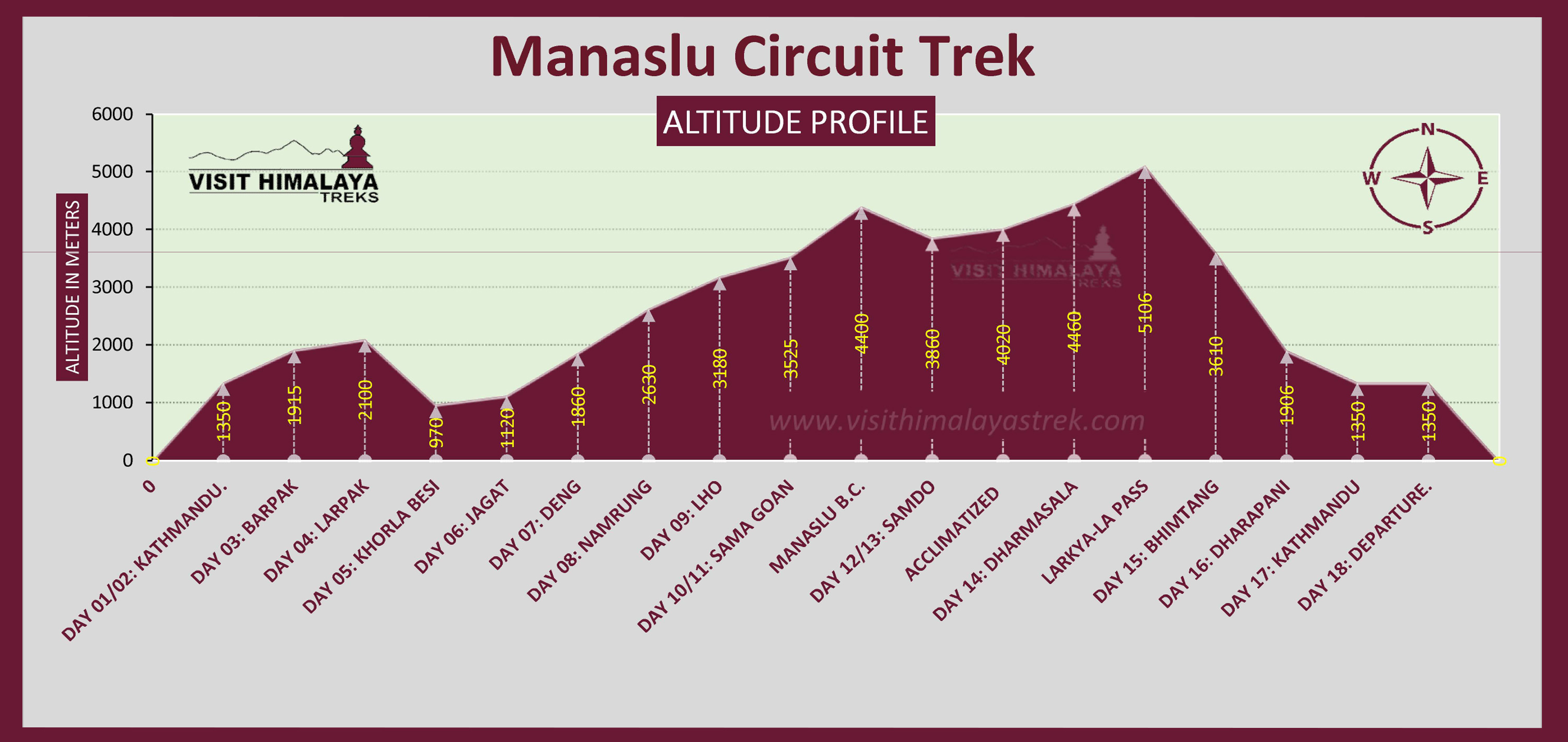
The Manaslu Circuit Trek is widely regarded as one of the most spectacular treks in Nepal, offering a mesmerizing journey through the enchanting landscapes of the Manaslu region. This off-the-beaten-path adventure takes you on an 18-day exploration of the Manaslu Conservation Area, providing a captivating experience for trekkers seeking awe-inspiring natural beauty and cultural immersion.
Commencing in the charming village of Soti Khola, situated at an altitude of 700 meters above sea level, the trek gradually unfolds, guiding you through a remarkable variety of terrains and ecosystems. As you venture northward along the high route, you'll traverse lush rice paddies, terraced fields adorned with water buffalo, and quaint thatched huts. The trail meanders through the captivating landscapes, revealing the captivating beauty of the region.
The Manaslu Circuit Trek presents a fantastic alternative for those who have already experienced the popular Annapurna Circuit. Flanked by the majestic Annapurna range to the west and the resplendent Ganesh Himal to the east, the trek provides a panoramic vista of the colossal 8000-meter peaks, creating an atmosphere of awe and wonder.
Unlike the crowded trails of the Everest Base Camp Trek, the Manaslu circuit route offers a more secluded and intimate experience. The trek attracts fewer visitors, allowing for a sense of tranquility and serenity amidst the rugged Himalayan wilderness. The remoteness of the region, combined with its physical challenges, makes the journey all the more rewarding. Moreover, the cultural richness of the local communities encountered along the way adds depth and authenticity to the trekking experience.
The trail follows the path of the Budi Gandaki River, leading you through mighty gorges adorned with turquoise waters and breathtaking waterfalls. Suspension bridges, renowned for their impressive length and height, provide thrilling crossings over the river. However, it's worth noting that some of the minor bridges may be washed away during the monsoon season, requiring trekkers to navigate across semi-submerged rocks.
Originally opened to a maximum of 400 trekkers in 1992, the Manaslu Circuit Trek still retains a sense of pioneering exploration. It offers a glimpse into what trekking in the 1980s was like providing a nostalgic experience for those seeking a connection to the past. However, it is essential to be physically fit and prepared for the challenges that the trek presents.
Gradually ascending northward, the journey takes you to the snowbound Larkya La Pass, situated near the Tibetan border at an altitude of 5,167 meters (16,952 feet). While the high altitude presents a challenge, the breathtaking views of Manaslu and the surrounding Himalayan peaks make it all worthwhile. The pass is typically covered in snow and ice, necessitating the use of micro crampons during the descent. Trekking to the pass requires an early start, usually around 3 am, to reach the summit before the winds intensify later in the morning.
As you continue beyond the pass, a magnificent glacial cirque unfolds before your eyes. The towering peaks of Cheo Himal, Himlung Himal, Nemjung, Gyaji Kang, and Kang Guru cascade down with glaciers, while the majestic Annapurna II stands proudly ahead. This awe-inspiring view alone makes the entire trek truly worthwhile, leaving an indelible mark on your memory.
For those seeking a well-organized and comprehensive trekking experience, Visit Himalaya Treks offer all-inclusive packages that cover the 18-day Manaslu Circuit Trek. Accommodations along the route are typically provided in teahouses, offering a comfortable resting place after a day of exhilarating trekking. However, if you prefer to explore off the beaten path, camping options are also available, allowing you to immerse yourself fully in the wilderness.
Manaslu Tsum Valley Trek - Explore Unexplored Tsum Nubri Valley.
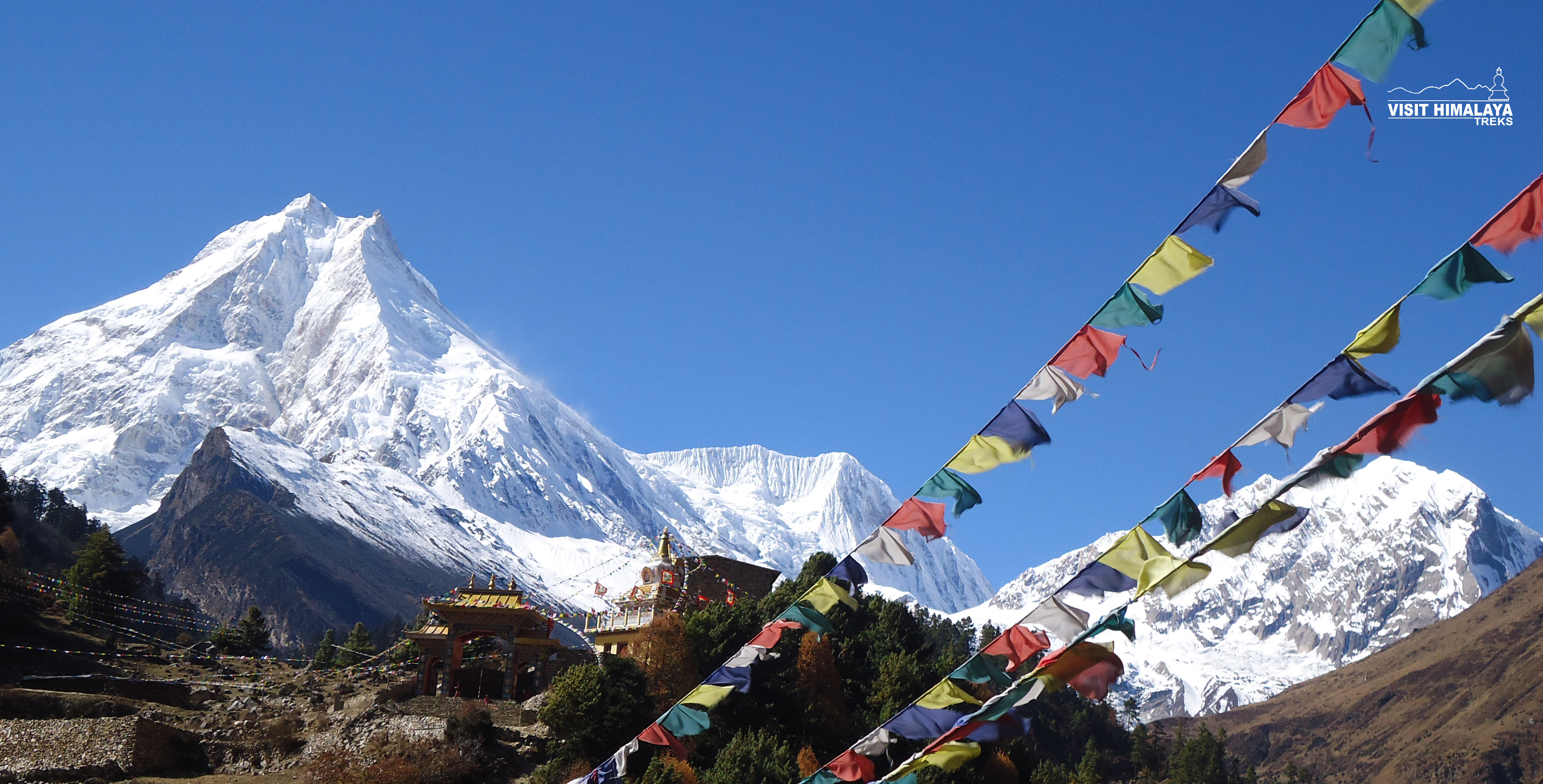
Manaslu Tsum Valley Trek's Trip Fact.
|
Maximum Elevation:
|
5106 meters, Larkya Pass
|
|
Trek Duration:
|
25 days
|
|
Best Season:
|
March-May, and October- November
|
|
Trek difficult:
|
Demanding
|
|
Accommodation Type:
|
Teahouse
|
|
Restricted Area:
|
Yes
|
|
Require Trekking Permits:
|
Tsum Valley Restricted area entry permits. Manaslu Restricted area entry permits. Manaslu Conservation Area (MCAP) Entry Permits Annapurna Conservation Area (ACAP) Entry Permits. Trekkers Information management system (TIMS) Card.
|
|
Starting / Ending Point:
|
Barpak / Dharapani
|
Manaslu Tsum Valley Trek's Highlight:
- Combining the Manaslu Circuit Trek with a visit to the hidden Tsum Valley.
- Exploring the sacred Buddhist pilgrimage sites and ancient monasteries of Tsum Valley.
- Scenic landscapes with terraced fields, remote villages, and high Himalayan peaks.
- Interacting with the warm and welcoming local communities.
The Manaslu Tsum Valley Trek in Nepal is an adventurous 25-day tea house trek, offering hikers the opportunity to intimately experience the awe-inspiring presence of Mount Manaslu. Standing tall as the eighth highest mountain globally, it reaches a majestic height of 8,163 meters. The trek also takes you through the hidden valley of Tsum. This trek opened in the early 1990s and has been able to preserve the beauty of nature from the outside world. While it is now open to trekkers, the area remains restricted, ensuring that the beauty and atmosphere remain intact.
Renowned as one of the finest treks in Nepal, the Manaslu Tsum Valley Trek offer hikers an exceptional opportunity to approach the awe-inspiring Mount Manaslu. It opened in the early 1990s and offers an exploratory and less crowded experience. Throughout the trek, you will encounter roaring rivers, waterfalls, challenging rocky paths along cliff sides, Gurung villages with terraced rice fields, long suspension bridges that test your mental stamina, as well as mani walls, chortens, and other Buddhist temples, particularly in the Tsum Valley route.
The Tsum Valley, also known as the Hidden Valley, offers a similar culture, people, and geography to Tibet. The trek takes you very close to the Tibetan border, providing opportunities to meet Buddhist nuns and monks and visit Milarepa's Cave. And Don't miss the opportunity to spot Nepal's national bird, the Lophophorus. Keep an eye out for the stunning Lophophorus, Nepal's national bird, and enjoy breathtaking views of Mount Manaslu, as well as the Simrang, Hiunchuli, Ngadi, Ganesh Himal, and Larkye Peak Himalayan ranges. From the Larkya La pass, you can admire icefalls, frozen lakes, Himlung Himal, Cheo Himal, Kangguru, and the enormous Annapurna II.
This trek is ideal for those who want to experience diverse civilizations and landscapes in one trip. It offers a unique and rewarding journey with magnificent views of snow-capped mountains. The Manaslu region provides a blend of natural and cultural richness, ranging from an altitude of 1,905m in Lhokpa to over 5,093m at the Ngula Dhojhyang Pass near the Tibetan border.
On average, each day of the trek involves walking for 6 to 7 hours, making it important to have a good level of fitness to fully explore the area. The trek provides breathtaking views of Mount Manaslu, as well as the Himalayan ranges of Simrang, Hiunchuli, Ngadi, Ganesh Himal, and Larkye Peak. From Larkya La, you can witness icefalls, frozen lakes, and the grandeur of the Himalayas.
Kanchenjunga Base Camp Trek - Trek around the World's third highest peak Including South and North Base Camp.
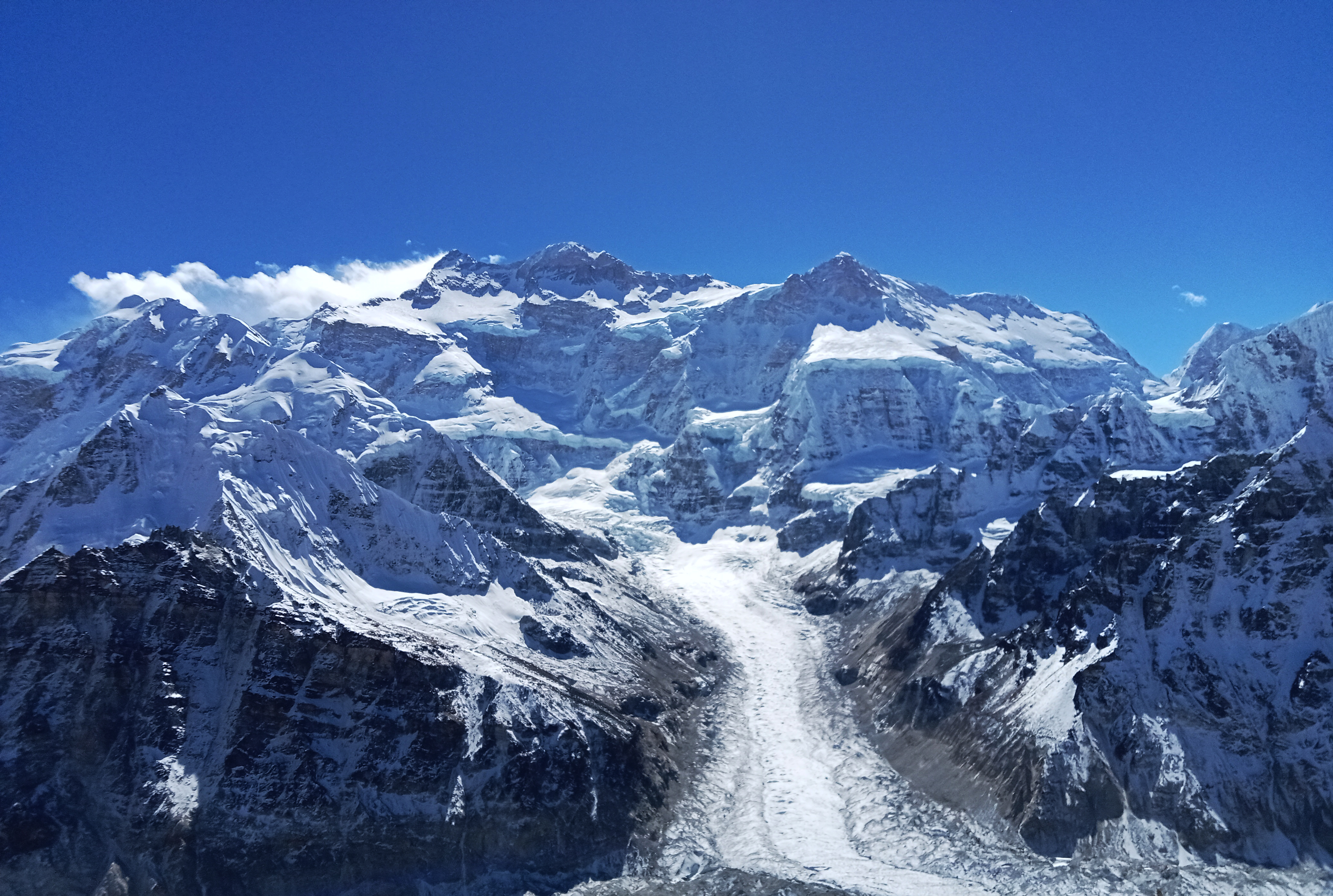
Kanchenjunga Base Camp Trek
Kanchenjunga Base Camp Trek's Trip Fact
|
Maximum Elevation:
|
5,200 meters, Pang Pema
|
|
Trek Duration:
|
26 days
|
|
Best Season:
|
March-May, and October- December
|
|
Trek Difficult:
|
Demanding
|
|
Accommodation Type:
|
Teahouse / Camping
|
|
Restricted Area
|
Yes
|
|
Required Trekking Permits
|
Kanchenjunga Restricted area entry permits. Kanchenjunga Conservation Area (KCAP) Entry Permits Trekkers Information management system (TIMS) Card.
|
|
Starting / Ending Point :
|
Suketar / Ranipul
|
Kanchenjunga Base Camp Trek's Highlight:
- Trekking in the remote and untouched region of Kanchenjunga, the third-highest peak in the world.
- Immersion in the rich biodiversity of Kanchenjunga Conservation Area.
- Experiencing the unique culture and traditions of the local communities, including Rai and Limbu ethnic groups.
- Panoramic views of Kanchenjunga, Makalu, and other Himalayan peaks.
Kanchenjunga Base Camp Trek's Altitude Profile
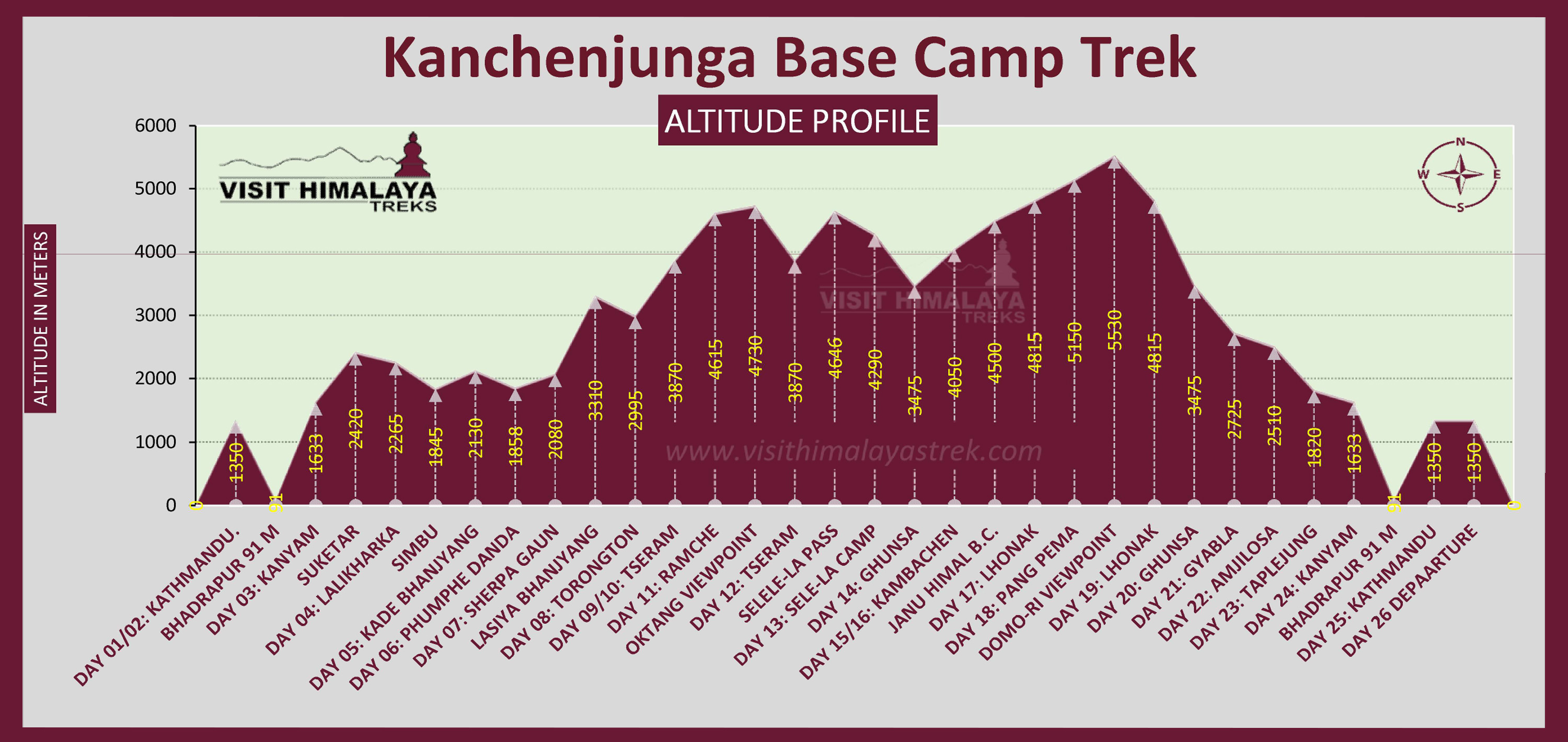
Kanchenjunga base camp trek is a 26-day holiday in the east of Nepal. It offers 22 days of actual trekking, covering 220 km in an area that is less visited by tourists. The trek showcases a variety of stunning scenery, ranging from lush tropical jungle to rhododendron, chestnut, and oak forests, and culminating at the glaciated base camp of the third-highest peak in the world. It's definitely the most desired destination for treks in Nepal amongst travelers.
Situated on the eastern side of Nepal, in close proximity to the border with Sikkim, a Himalayan state in northeastern India, lies the captivating region of Kanchenjunga. In the past, it was believed to be the highest peak in the world until the mid-1800s. The route to Kanchenjunga Base Camp takes you through the picturesque Arun Valley, renowned as one of Nepal's most beautiful trekking regions. A highlight of the trek is the Kanchenjunga Conservation Area, covering a vast expanse of 2035 square kilometers and teeming with diverse flora and fauna.
The region is home to Himalayan black bears, musk deer, snow leopards, red pandas, wild boars, and more. During the trek, adventurers encounter a diverse terrain encompassing alpine grasslands, sub-tropical forests, low river valleys, glacial moraines, and rocky scree slopes. Along this captivating journey, trekkers are treated to breathtaking vistas of towering peaks like Lhotse, Everest, Kanchenjunga, Makalu, and many more. The Kanchenjunga region is inhabited by a mix of Sherpa, Rai, Limbu, and Gurung communities, providing an enriching cultural experience.
In addition to the main peak of Kanchenjunga, there are four subsidiary summits exceeding 8,000m, with Kanchenjunga West (Yalung Kang) being the most significant. The region is also home to around twenty peaks surpassing 7,000m, including Kambachen, Janu, Jongsong, Kabru, Tent Peak, and the Twins. Moreover, numerous peaks above 6,000m grace the area. The presence of five major glacial systems, including Zumu, Talung, Rathong, Kanchenjunga, and Yalung glaciers, further enhances the natural beauty of the region.
The Kanchenjunga Circuit trek encompasses both the north and south base camps of Mount Kanchenjunga, the third-highest mountain in the world at 8,586m. While this is a remote trekking area that requires a good level of fitness and some trekking experience, it offers a unique opportunity to witness the local way of life and visit Ramtang and Oktang Monasteries. This area was closed to trekkers until the mid-1980s but is now protected by the Kanchenjunga Conservation Area, ensuring the preservation of its beautiful and diverse flora and fauna.
To trek in Kanchenjunga, visitors must fulfill certain requirements, as the number of trekkers is restricted. A local guide and a minimum of two trekkers are necessary to obtain the required permits. We specialize in organizing small group treks with customized dates, providing expert advice, meticulous preparation, and exceptional care during the trek. Trekking in Kanchenjunga offers an unforgettable experience that can definitely be on the list of treks in Nepal.
Makalu Base Camp Trek - One of the Pure Off the beaten Trek to Mt. Makalu.
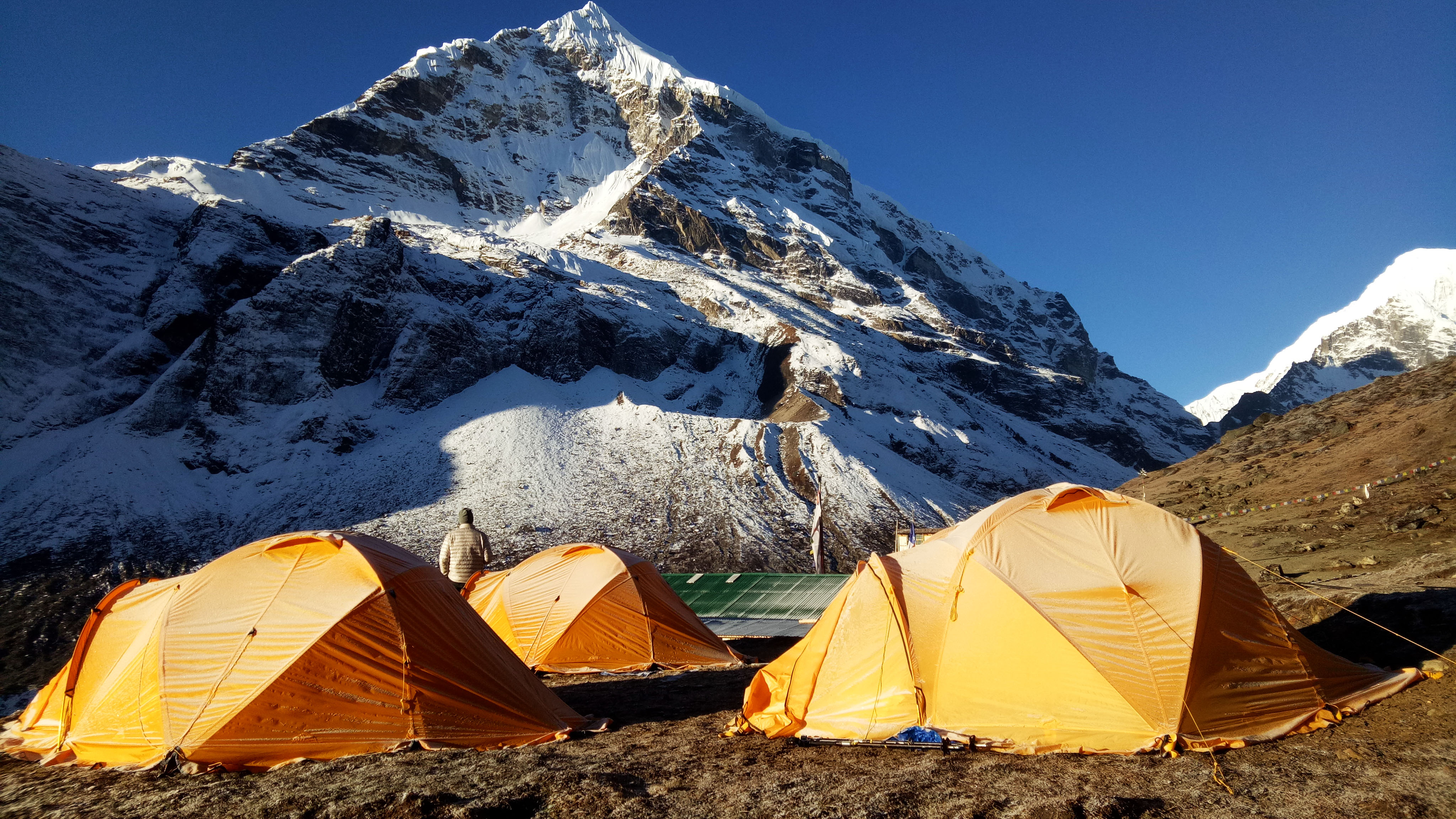
Makalu Base Camp Trek's Trip Fact
|
Maximum Elevation:
|
5250 meters, Shersong Ridge
|
|
Trek Duration:
|
19 days
|
|
Best Season:
|
March-May, and October- November
|
|
Trek Difficult:
|
Demanding
|
|
Accommodation Type:
|
Teahouse / Camping
|
|
Restricted Area:
|
No
|
|
Required Trekking Permits
|
Makalu Conservation Area (MCAP) Entry PermitsTrekkers Information management system (TIMS) Card.
|
|
Starting / Ending Point:
|
Num
|
Makalu Base Camp Trek's Highlight:
- Trekking to the base camp of Mount Makalu, the fifth-highest peak in the world.
- Remote and less crowded trail with pristine natural beauty.
- Passing through diverse ecosystems, including lush forests, alpine meadows, and high-altitude glaciers.
- Spectacular views of Makalu, Everest, Lhotse, and other surrounding peaks.
Makalu Base Camp Trek's Altitude Profile:
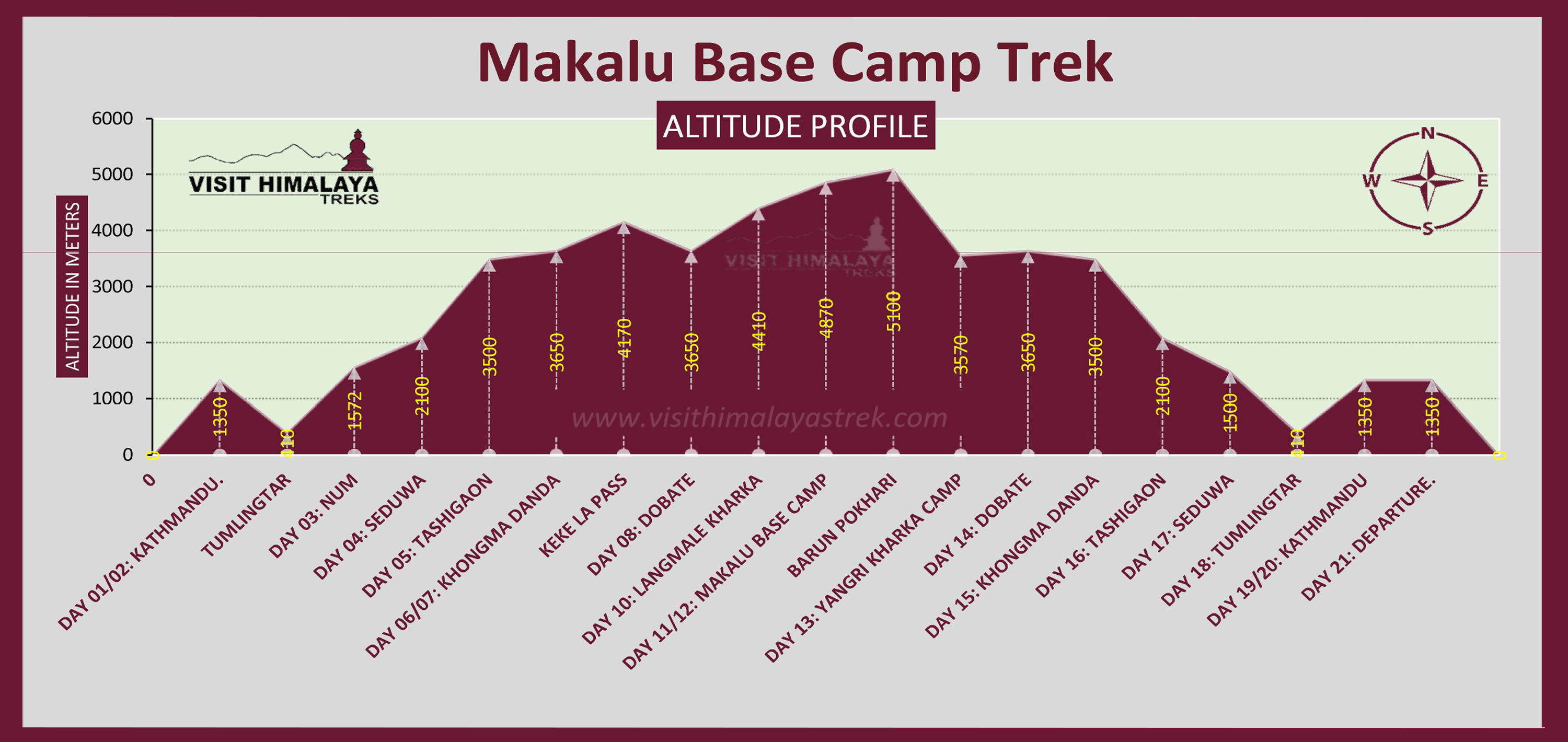
The Makalu Base Camp trek presents a distinctive and thrilling opportunity, guiding you through high-altitude regions, snowy landscapes, and the captivating Himalayan way of life. The base camp, situated at 5250 meters, is now designated as Makalu Barun National Park and Conservation Area. Makalu, the fifth-highest peak in the world, dominates the region with its majestic presence. The trek is known for its breathtaking scenery, which never fails to captivate trekkers.
Starting from Tumlingtar, the Makalu Base Camp trek follows the Arun River valley, passing through Sedua and Num, and crossing the challenging Shipton La Pass (4210 m) into the upper Barun River valley. This remote and unfrequented area is part of an international protected area agreement between Nepal and China. The trek offers a close look at the magnificent Makalu and Chamlang Himal mountains. Commencing in lush, terraced farmlands where the Rai people dwell, the expedition progresses with each ascent. Traverse through rhododendron and cloud forests, immersing yourself in the untouched beauty of Nepal's dwindling pristine forests and alpine meadows.
Further into the mountains, you'll encounter steep granite cliffs, glaciers, and spectacular waterfalls. The Sherpa people, who reside near Everest, inhabit the higher elevations. Upon reaching Makalu Base Camp, behold awe-inspiring vistas of the seldom-seen Kangshung face of Everest, alongside Lhotse, Chamlang, and Kanchenjunga on the distant eastern horizon. Encompassing an expansive area of 2,330 square kilometers, the Makalu Barun National Park unveils its splendor. is home to rare flora and fauna, including the Red Panda.
Previously considered a hidden gem, the trek to Makalu Base Camp is now accessible as a tea house trek, offering accommodation along the way, although simpler compared to more established trekking areas. The trek presents a challenging but immensely rewarding adventure, crossing high passes and offering splendid isolation. The vistas are equally breathtaking in both directions, with the advantage of a second chance to see obscured views on the return journey.
The Makalu Base Camp trek takes you through the pristine wilderness of Makalu Barun National Park, renowned for its natural beauty and diverse flora and fauna. It is a trek of varying landscapes and cultures, providing uncommon views of some of the world's tallest mountains, including Everest. The Makalu Base Camp trek is a less-explored and challenging trek in Nepal that leads you through remote and untouched wilderness. It offers stunning views, cultural experiences, and an opportunity to appreciate the beauty of Makalu and its surroundings.
Dhaulagiri Circuit Trek - Challenging treks Around Mt. Dhaulagiri.
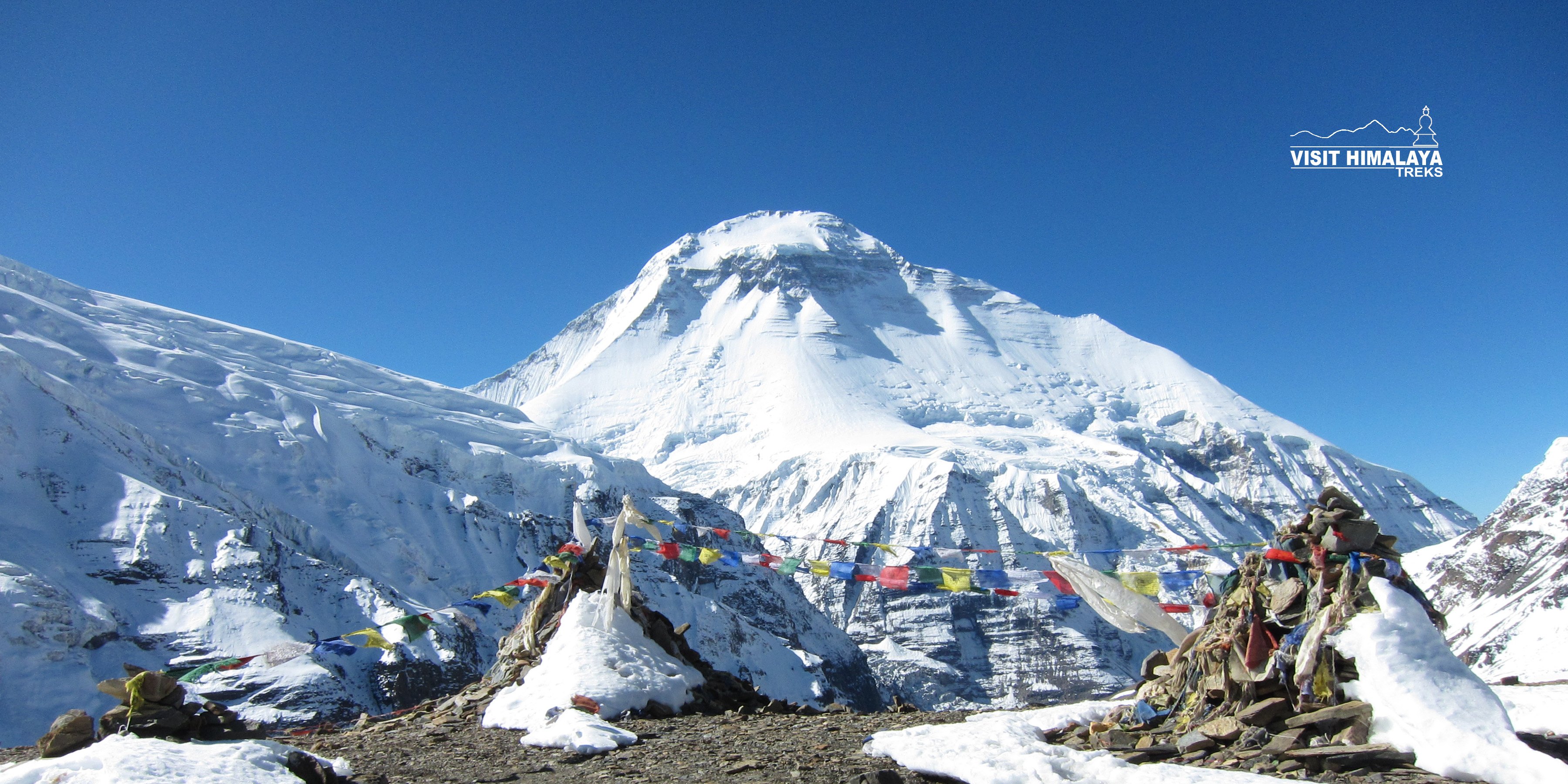
Dhaulagiri Circuit Trek's Trip Fact.
|
Maximum Elevation:
|
5360 meters, French Pass
|
|
Trek Duration:
|
18 days
|
|
Trek Difficulty:
|
Demanding +
|
|
Accommodation Type:
|
Camping
|
|
Best Season:
|
April-May, and October- November
|
|
Restricted Area:
|
Yes
|
|
Required Trekking Permits
|
Annapurna Conservation Area (ACAP) Entry PermitsTrekkers Information management system (TIMS) Card
|
|
Starting/ Ending Point :
|
Darbang / Jomsom
|
Dhaulagiri Circuit Trek's Highlight:
- Encircling the Dhaulagiri massif, the seventh highest peak in the world.
- Crossing the challenging French Pass and Dhampus Pass.
- Exploration of the hidden valleys, glaciers, and high mountain passes.
- Breathtaking views of Dhaulagiri, Annapurna, and other Himalayan peaks.
Dhaulagiri Circuit Trek's Altidude Profile:
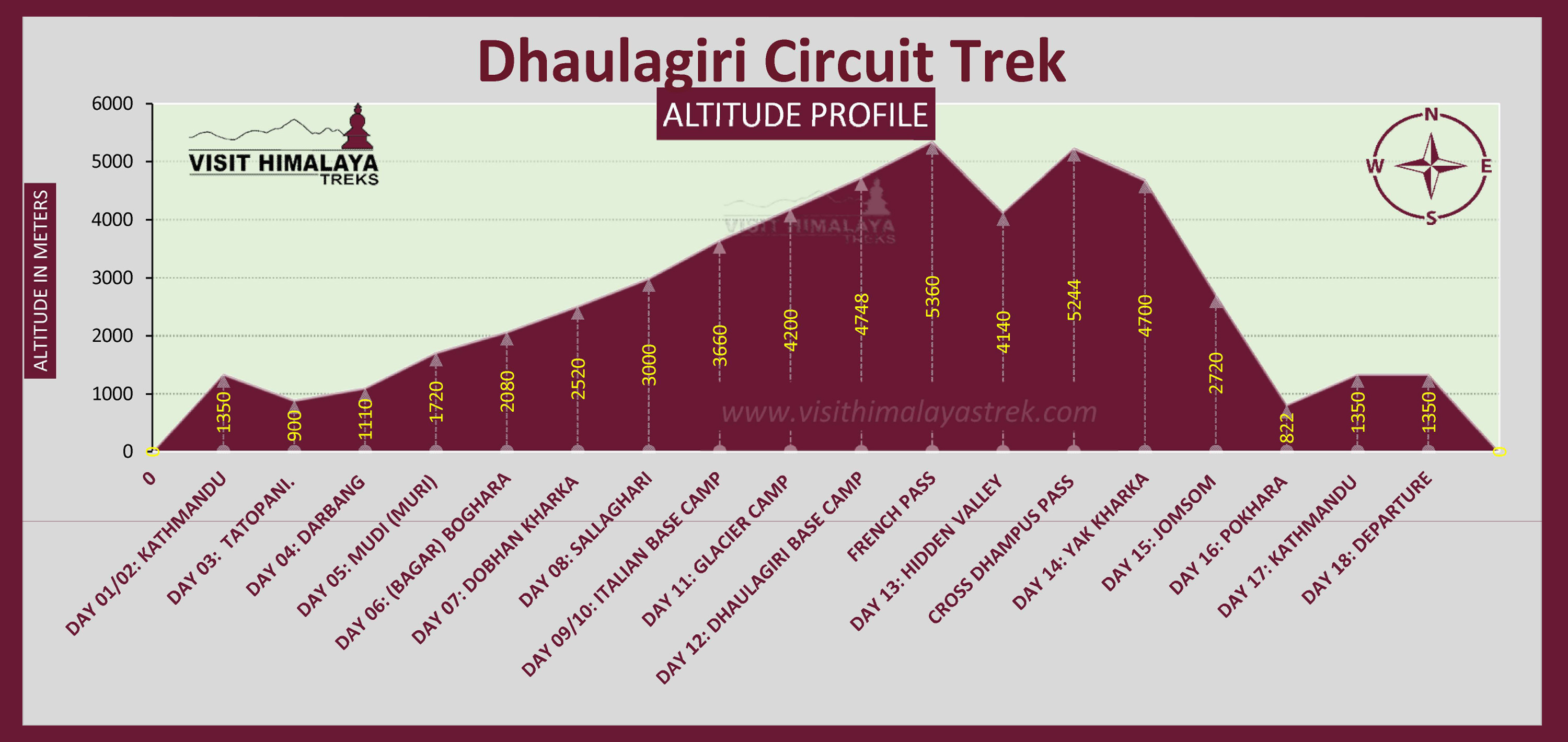
The Dhaulagiri Circuit Trek is a challenging and remote trek in Nepal that takes you through various terrains, including high alpine pastures, valleys, windy passes, forests, and terraced hills. It features two high passes, the French Pass at 5,360m and Dhampus Pass at 5,200m, as well as the Dhaulagiri Base Camp at 4,740m. This trek requires a high level of fitness and basic mountaineering skills. However, the effort is rewarded with breathtaking views of Tukuche Peak, Dhaulagiri I, Dhaulagiri II, Dhaulagiri III, and Dhaulagiri V.
Dhaulagiri, standing at 8,167m, is the seventh-highest mountain in the world and offers stunning views along the trek. The route follows the Dhaulagiri range, which rises above the Kali Gandaki Gorge, the deepest gorge in the world. The trek also takes you through villages, terraced farmland, rivers, gorges, glaciers, and moraine. Ample time is provided for acclimatization before tackling the high passes, allowing trekkers to enjoy the magnificent mountain vistas.
The trek begins with a drive from Kathmandu to Beni via the Prithivi National Highway. From Beni, the trek proceeds to Darbang, passing through dense forests and villages inhabited mainly by the Magar people. The trail continues through villages like Dharapani, Sibang, Muri, Naura, Lapche Kharka, and Darbang. Acclimatization is done at the Italian Base Camp, offering views of Churen Himal, Gurja, Ghustung South, Tsarabang Peak, Jirbang, and Manapati. From there, the trek continues to Dhaulagiri Base Camp, where trekkers witness the stunning icefall between Dhaulagiri and Tukuche Peak.
The Dhaulagiri Circuit Trek is known for its difficulty and demands a high level of physical fitness. It is a remote and isolated trek that takes you through rugged landscapes and requires endurance and perseverance. The trek is well-suited for experienced trekkers who seek a challenging adventure and want to explore the raw natural beauty of the Dhaulagiri region.
Throughout the trek, you will be immersed in the rural lifestyle and rich culture of the area. The trek concludes with a flight from Jomsom to Pokhara and then back to Kathmandu. Overall, the Dhaulagiri Circuit Trek offers a unique and unforgettable experience for those who are prepared to take on its physical demands and explore the stunning Himalayan landscapes.t to explore the raw natural beauty of the Dhaulagiri region.
Upper Dolpo Trek - Trek to the Land of Isolated rugged and Remote corner of Dolpo Nepal.
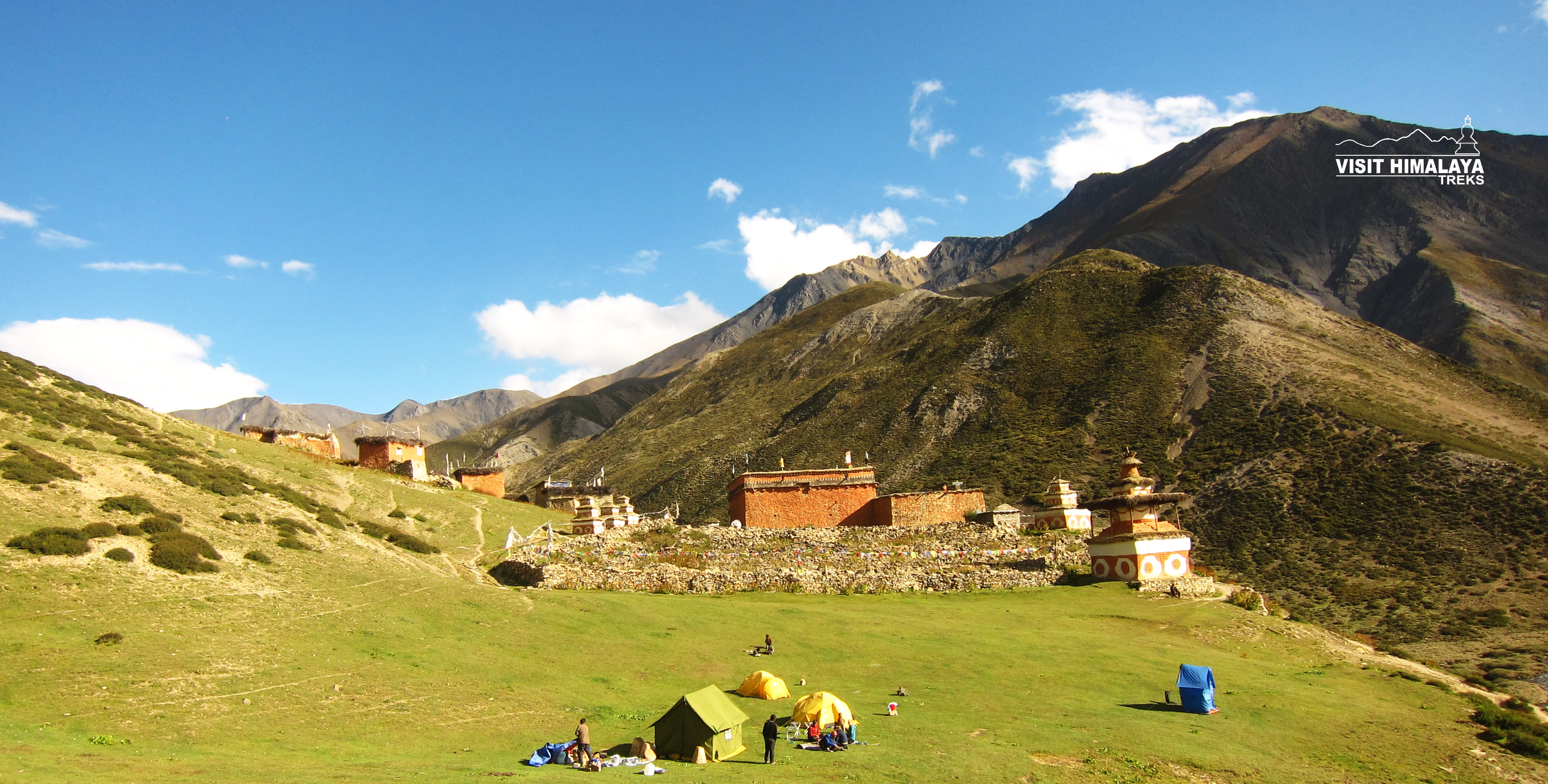
Upper Dolpo Trek's Trip Fact
|
Maximum Elevation:
|
5,345 meters, Kang La Pass
|
|
Trek Duration:
|
28 days
|
|
Best Season:
|
April to November
|
|
Trek Difficulty:
|
Demanding +
|
|
Accommodation Type:
|
Camping
|
|
Restricted Area:
|
Yes
|
|
Require Trekking Permits:
|
Upper Dolpo Restricted area entry permits.Lower Dolpo Restricted area entry permits.Shey Phoksundo National Park Entry Permits.
|
|
Starting / Ending Point :
|
Jufal / Jomsom
|
Upper Dolpo Trek's Highlight:
- Trekking in the remote and mystical region of Dolpo, known for its ancient Bon and Buddhist cultures.
- Crossing high passes, including Kang La and Jeng La, offering stunning mountain vistas.
- Visiting the Shey Phoksundo National Park, with its crystal-clear Phoksundo Lake.
- Immersion in the traditional lifestyle and customs of the Dolpo people.
Upper Dolpo Trek's Highlight:
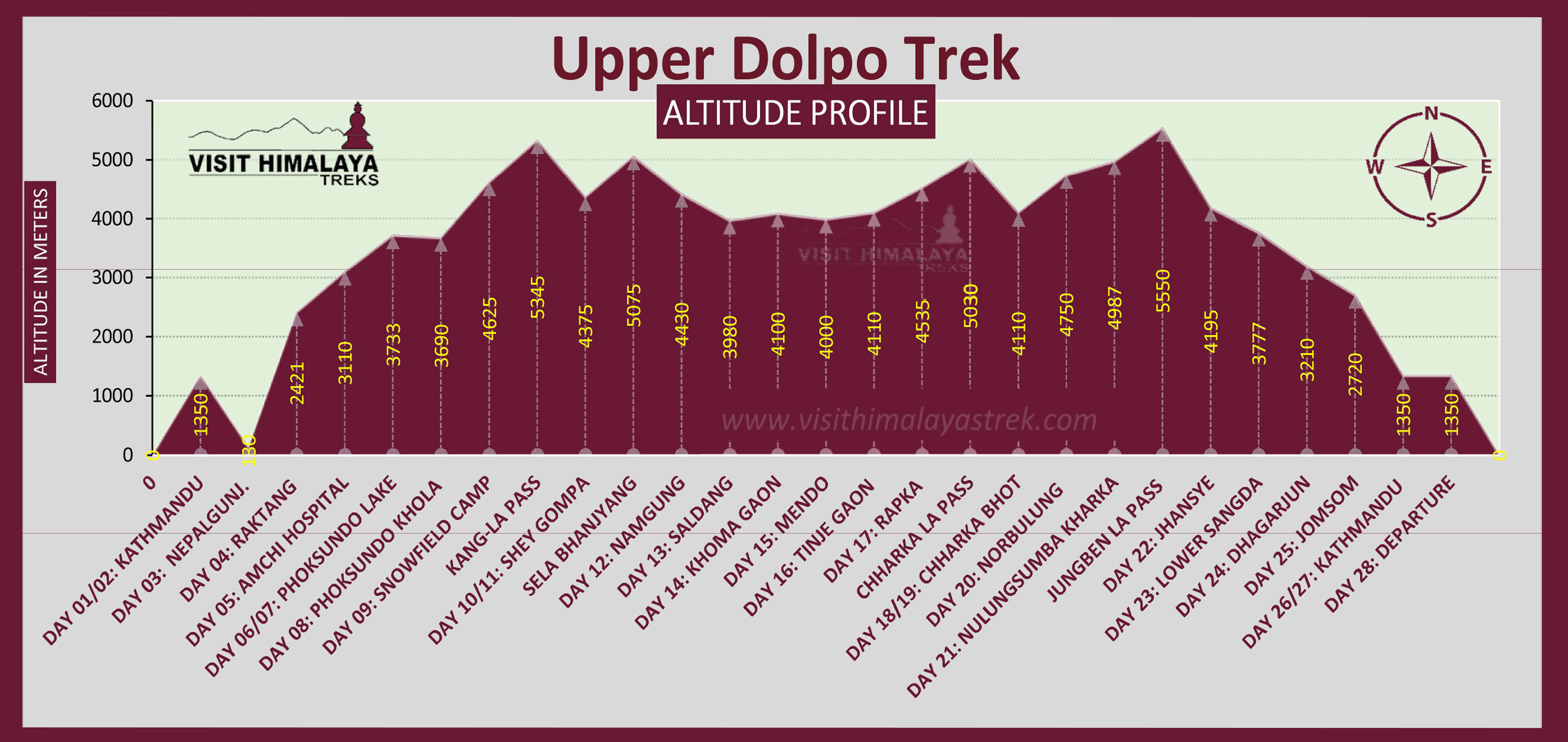
Trekking in Nepal's Dolpo region offers a unique experience in the rugged and remote far west. Bordering Tibet, Dolpo shares similarities in culture and landscape with its northern neighbor. The western part of the district is home to She-Phoksundo National Park, Nepal's largest national park.
The Upper Dolpo trek in Nepal is an adventurous journey through the remote and underdeveloped landscape of western Nepal. It follows the ancient salt trading route and includes attractions like the picturesque Shey Phoksundo Lake, high mountain passes, and majestic mountains. The dry terrain stretching between the Dhaulagiri massif and the Tibetan plateau is abundant in ancient Tibetan Buddhist heritage. Traditional monasteries, vibrant ethnic communities, and untouched natural beauty await trekkers who embark on this off-the-beaten-path adventure.
While remote and underdeveloped, Western Nepal showcases the natural beauty and is a destination for intrepid trekkers. Infrastructure for tourism in Dolpo is limited, requiring camping and self-sufficiency in terms of food supplies. Permits are expensive, and trekking in Upper Dolpo must be done with a guide. Despite the challenges, the rewards of trekking in Dolpo are remarkable. Deep valleys, high passes, peaks, the turquoise Lake Phoksundo, the ancient Shey Monastery, and rare wildlife like the elusive snow leopard await those who venture here. The Dolpo region, though influenced by the Tibetan Plateau, remains unexplored and maintains its natural beauty. It is an essential destination for trekking in Nepal for trekkers seeking serenity.
The Upper Dolpo Trek opened for tourism in 1989, belongs to the Shey Phoksundo National Park, and offers a one-of-a-kind experience at altitudes above 4,000 meters. The trek begins from the modest airstrip of Juphal, the trek traverses through villages, providing vistas of lush forests and occasional glimpses of majestic snow-capped peaks. It reaches the magnificent Shey Phoksundo Lake, situated at an altitude of 3,600 meters. The Kang-La Pass connects the Phoksundo Valley and Shey Gompa, providing breathtaking mountain and landscape vistas. A visit to Shey Gompa and the crystal mountain adds to the tranquility and charm of the trek.
The Dolpo region is also known for its distinctive clothing, traditional crafts, and rare wildlife. Within the Shey Phoksundo National Park reside endangered species such as the snow leopard, musk deer, and blue sheep. The stunning Phoksundo Lake, surrounded by high mountains, adds to the allure of the trek. Beyond the natural beauty and impressive scenery, the trail reveals hidden gems like Saldang and Yangtser Gumpa, which are lesser-known aspects of Upper Dolpo.
This journey truly showcases the retreat-like beauty of the region. Undertaking the Upper Dolpo Trek requires good physical fitness and prior trekking experience. The best time for the trek is from May to October, ensuring favorable weather and ideal trekking conditions. The Upper Dolpo Trek offers a unique and off-the-beaten-path trek in Nepal. With its stunning landscapes, rich cultural heritage, and rare wildlife, it is an excellent choice for trekkers seeking something extraordinary.
Rara Upper Dolpo Trek via GHT trail - Challange with high altitude passes over 5000 meters following the Upper Great Himalayan Trail route.
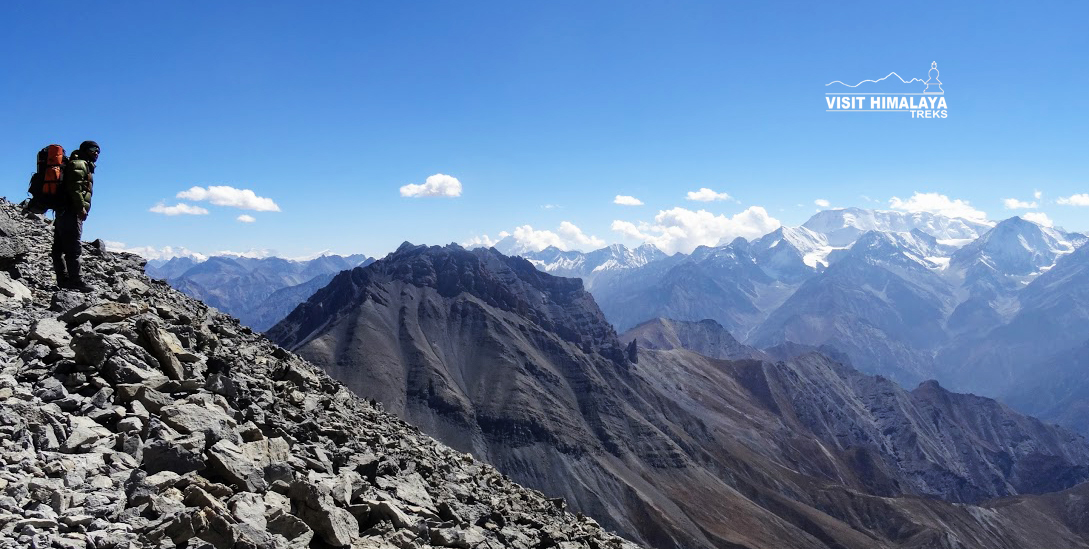
Rara Upper Dolpo Trek via GHT trail's Trip Fact.
|
Maximum Elevation:
|
5,563 meters, Nyingma Gyanzen La Pass
|
|
Trek Duration:
|
42 days
|
|
Best Season:
|
April to November
|
|
Trek Difficulty:
|
Challenging
|
|
Accommodation Type:
|
Camping
|
|
Restricted Area:
|
Yes
|
|
Require Trekking Permits:
|
Upper Dolpo Restricted area entry permits.Lower Dolpo Restricted area entry permits.Rara National Park Entry Permits.Shey Phoksundo National Park Entry Permits.
|
|
Starting / Ending Point :
|
Jumla / Jomsom
|
Rara Upper Dolpo Trek via GHT Highlight:
- Combining the beauty of Rara Lake with the remote trails of Upper Dolpo.
- Trekking through the Rara National Park, home to the pristine Rara Lake.
- Experiencing the wilderness of Upper Dolpo and its unique cultural heritage.
- Spectacular views of the Himalayan peaks and encounters with diverse flora and fauna.
Rara Upper Dolpo Trek via GHT Trek's Altitude Profile :
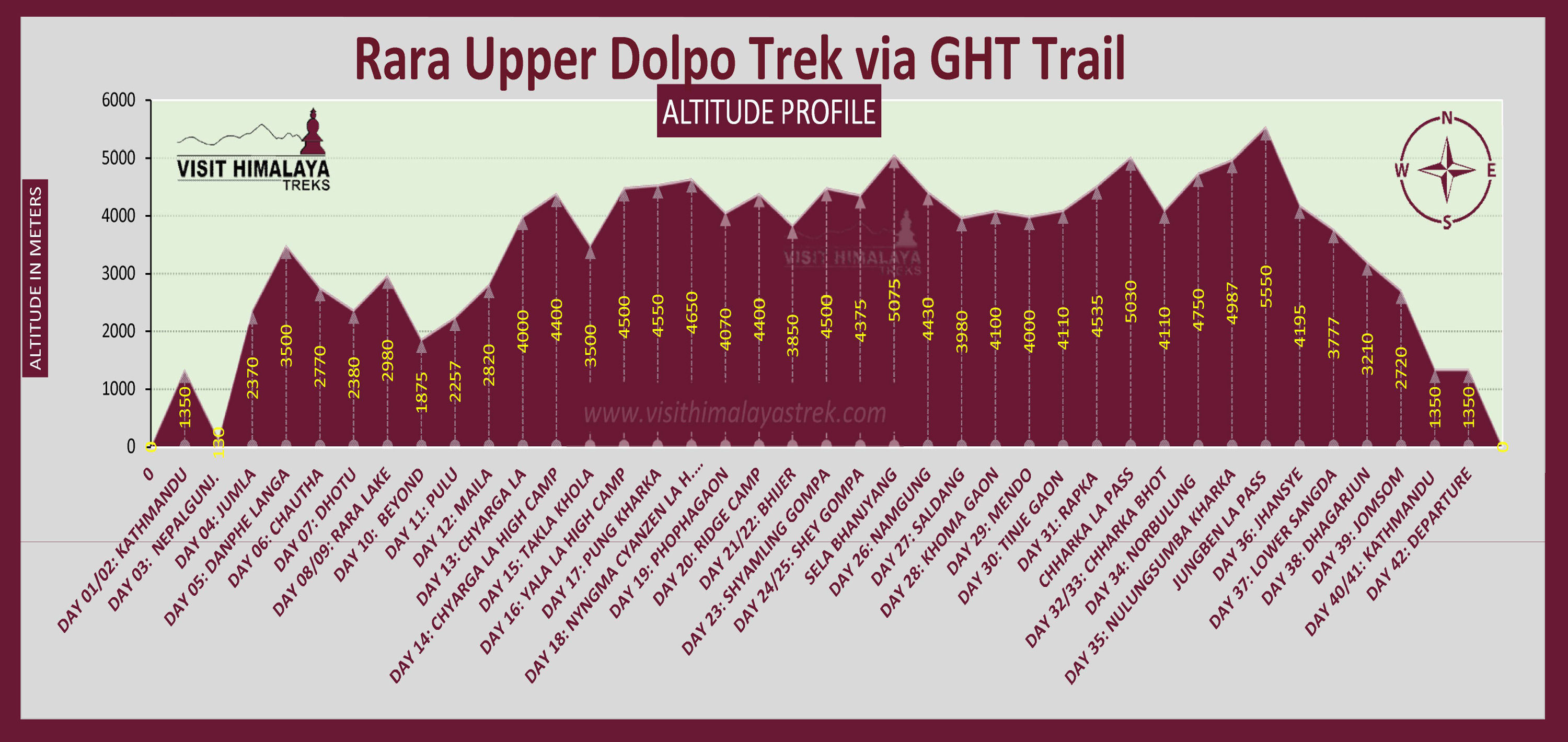
The Rara Upper Dolpo Trek via GHT Trail is the most challenging and remote wilderness trek in Nepal that connects Rara Lake to Jomsom through the Upper Dolpo region along the Upper Great Himalayan trail. This trek takes you through the secluded Mugu Karnali River and involves crossing the difficult high pass known as Nyingma Gyanzen La Pass (5563 meters), which leads to the remote villages of Phophagon and Bhijer in Upper Dolpo.
The journey from Jumla to Upper Dolpo via the Upper Great Himalayan Trail is a unique and breathtaking trekking experience. It encompasses the majestic Rara Lake, the largest lake in Nepal, and traverses the rugged Mugu Karnali region to reach Upper Dolpo by crossing the challenging Nyingma Gyanzen La Pass at an altitude of 5563 meters. From there, the trek follows the demanding Inner Dolpo route towards Jomsom via Niwar Pass (5510 meters). You can find more information and images of the Jumla to Jomsom Great Himalaya Trail (GHT) and Upper Dolpo trek in the provided links.
As road networks expand in Nepal and improve the lives of villagers, trekkers are increasingly seeking out more remote areas to experience solitude and the ancient rhythms of traditional villages. Dolpo, located northwest of Mt Dhaulagiri and spanning the Himalayas, offers an unparalleled experience in this regard. Upper Dolpo stands as one of the most elevated habitable areas on our planet and is recognized for its remarkable isolation.
Culturally, Dolpo shares Tibetan influences and borders Tibet. It is a high and arid region surrounded by passes over 5000 meters to the west, south, and east. Much of the area falls within the Shey Phoksundo National Park, Nepal's largest national park, covering 3555 square kilometers. The park is home to the 800-year-old Shey Gompa, located beneath the revered Crystal Mountain, as well as the spectacular Kanjiroba mountain range. The population of Upper Dolpo is sparse, consisting mainly of pastoral families who follow the Bon religion, a pre-Buddhist tradition accepted as a sect of Buddhism
To embark on one of the best destinations for treks in Nepal-the Rara Lake Upper Dolpo Trek via GHT Trail, you will need to take a flight from Kathmandu to Nepalganj in western Nepal and then another flight to Jumla, where the trek begins. Jumla is a beautiful starting point for this challenging and long trek, which includes Rara Lake and several high passes such as Chyargo Pass (5150 meters), Yala Pass (5414 meters), and Nyingma Gyanzen Pass (5563 meters). The trek continues through Bhijer, Shey Gompa, Saldang, ShimenGaon, Tinje, Rakpa, and Mola Pass, connecting to Chharka Bhot, and finally reaching Jomsom.
The entire trek lasts 42 days as organized by Visit Himalaya Treks. Due to the remote nature of the trek, accommodation options are limited. Tea houses or lodges are not available along this route, so full camping arrangements with a team of experienced staff, including a cook, helpers, and porters, are necessary. High-quality gear is also essential for the Rara Lake Upper Dolpo Trek via the GHT Trail.
Rara Lake Trek - The Biggest Lake in Nepal which is known as Piece of Heaven.
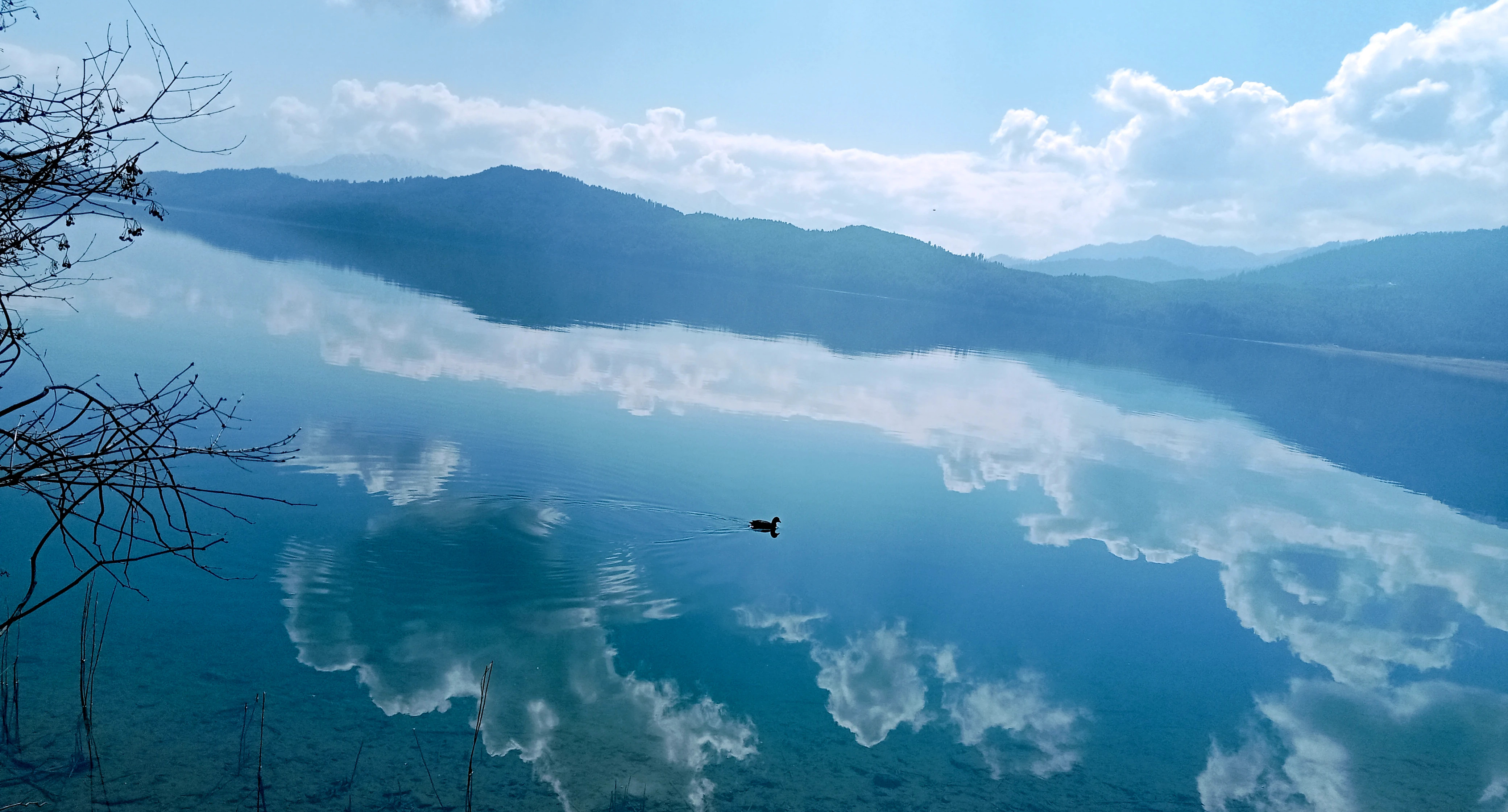
Rara Lake Trek's Trip Fact.
|
Maximum Elevation:
|
3500 meters, Danphe Langa
|
|
Trek Duration:
|
17 days
|
|
Best Season:
|
March-May, and October- December
|
|
Trek Difficulty:
|
Moderate
|
|
Accommodation Type:
|
Camping / Home Stay
|
|
Restricted Area:
|
No
|
|
Require Trekking Permits:
|
Rara National Park Entry Permits.
|
|
Starting / Ending Point :
|
Jumla / Jumla
|
Rara Lake Trek's Highlight:
- Exploration of the beautiful Rara Lake, the largest lake in Nepal.
- Walking through tranquil forests of pine, spruce, and rhododendron.
- Interaction with the local Thakuri and Magar communities.
- Scenic mountain views and diverse wildlife in Rara National Park.
Rara Lake Trek's Altitude Profile:
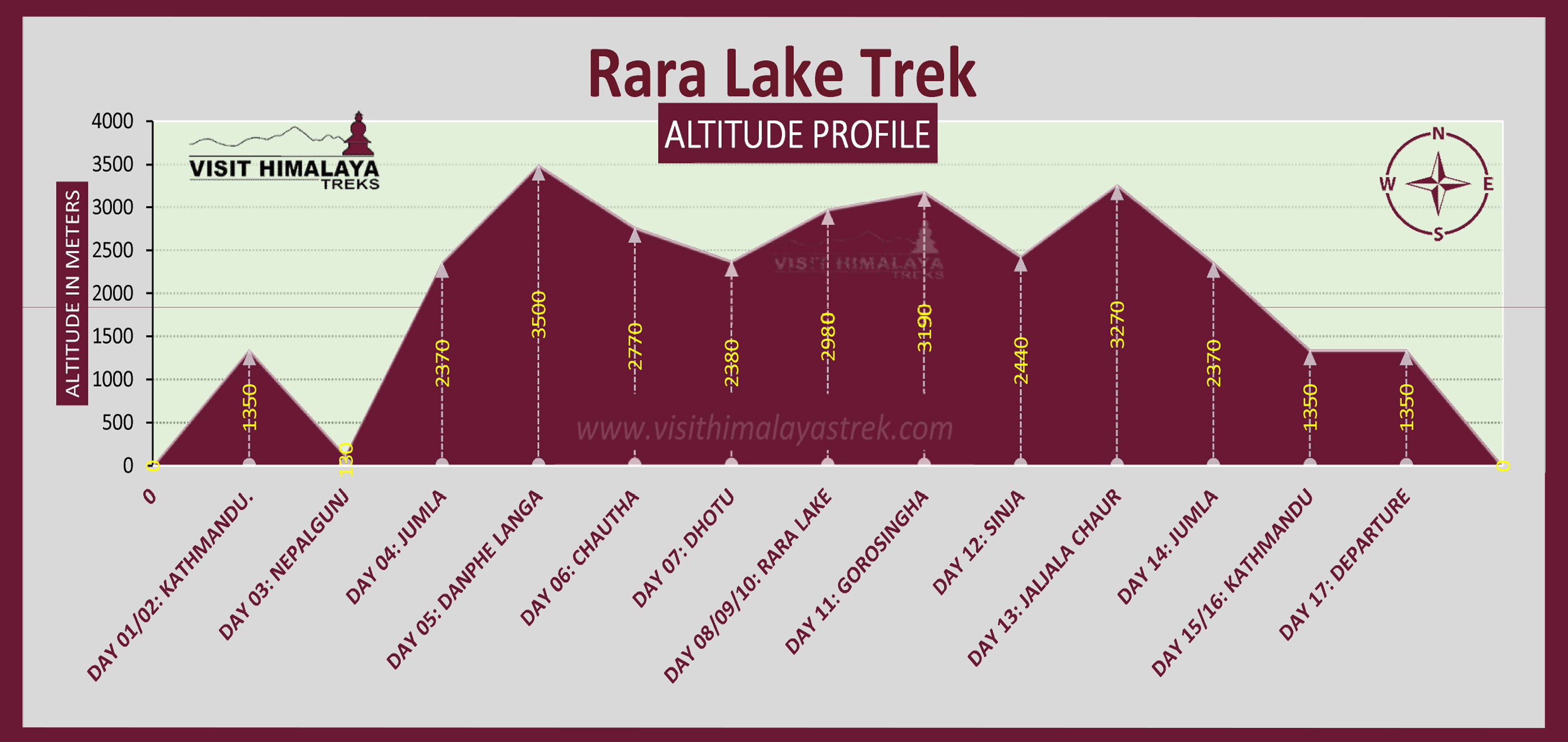
Another best destination for treks in Nepal is Rara Lake. You will experience an enchanting expedition through the secluded regions of Mugu and Jumla in the Karnali Region of Nepal with the mesmerizing Jumla Rara Lake trek. This trek offers a unique opportunity to explore the natural wonders of the area, with the highlight being the magnificent Rara Lake. Immerse yourself in stunning landscapes, rich biodiversity, and a genuine off-the-beaten-path experience.
Rara Lake: A Gem in the Himalayas, also known as Mahendra Taal, is the largest lake in Nepal, located at an altitude of 2,990m. Covering over 10 sq. km and reaching a depth of 167m, this sparkling turquoise-blue lake is a breathtaking sight. Situated in Rara National Park, it is surrounded by pine forests and is home to diverse bird species, including migratory birds. The trek offers a wonderful opportunity for birdwatching enthusiasts, with 214 species of birds, including the national bird of Nepal, the Danfe, commonly spotted.
The area is also rich in wildlife, with musk deer, Himalayan black bears, red pandas, and jackals among the inhabitants. Explore the tranquil forests of juniper, pine, and spruce, while enjoying glimpses of the snow-capped Himalayas in the distance. As you traverse the Rara Lake trek, you will encounter arid landscapes due to the rain-shadow effect of the Dhaulagiri and Annapurna ranges. Be captivated by the panoramic views of Chucchemara Peak, Ruma Kand, and Malika Kand. The lake's surroundings boast Malla stones, ancient pillars with inscriptions dating back to the 12th century, adding to the region's historical charm.
Rara Lake Trek is one of the Off the Beaten Path Treks in Nepal. It lets you escape the crowds and embark on an authentic journey through the unexplored territories of western Nepal. The Rara Lake trek offers a lesser-known route, allowing you to immerse yourself in the serenity of nature. While the trails involve moderate altitudes, trekkers with a reasonable level of fitness can successfully complete this trek. Experience the rugged beauty of the Himalayas as the trails take you up and down, revealing hidden wonders along the way.
Embarking on the Rara Lake trek is an invitation to uncover the remote beauty of Nepal's Jumla and Mugu districts. With Rara Lake as its crown jewel, this trek offers a unique blend of natural splendor, rich biodiversity, and authentic cultural encounters. Be enchanted by the pristine lake, surrounded by awe-inspiring landscapes and the serene ambiance of the Himalayas. The Rara Lake trek promises an unforgettable adventure in the heart of Nepal's wilderness.
Ghorepani Poon Hill Trek - Easy and Soft Treks for Everyone.
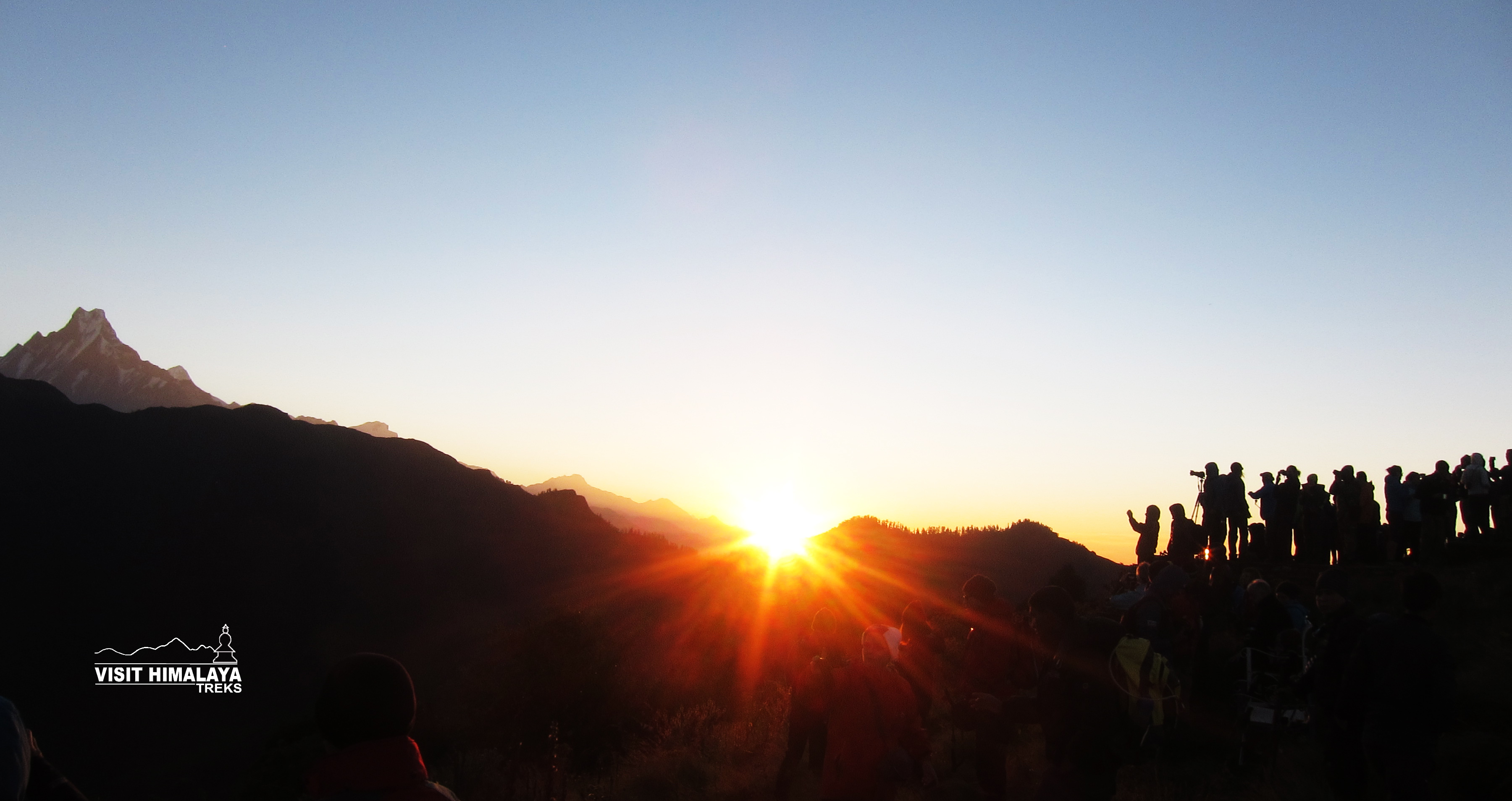
Ghorepani Poon Hill Trek's Trip Fact.
|
Maximum Elevation:
|
3210 meters, Poon Hill
|
|
Trek Duration:
|
08 days
|
|
Best Season:
|
March-May, and October- December
|
|
Trek Difficulty:
|
Easy
|
|
Accommodation Type:
|
Teahouse
|
|
Restricted Area:
|
No
|
|
Require Trekking Permits:
|
Annapurna Conservation Area (ACAP) Entry Permits Trekkers Information management system (TIMS) Card
|
|
Starting / Ending Point:
|
Hile / Ghandruk
|
Ghorepani Poon Hill Trek's Highlight:
- Short and popular trek in the Annapurna region, ideal for beginners.
- Breathtaking sunrise views from Poon Hill, offering panoramic views of the Annapurna and Dhaulagiri ranges.
- Walking through charming villages, terraced fields, and dense rhododendron forests.
- Immersion in the unique culture and traditions of Gurung and Magar communities.
Ghorepani Poon Hill Trek's Altitude Profile:
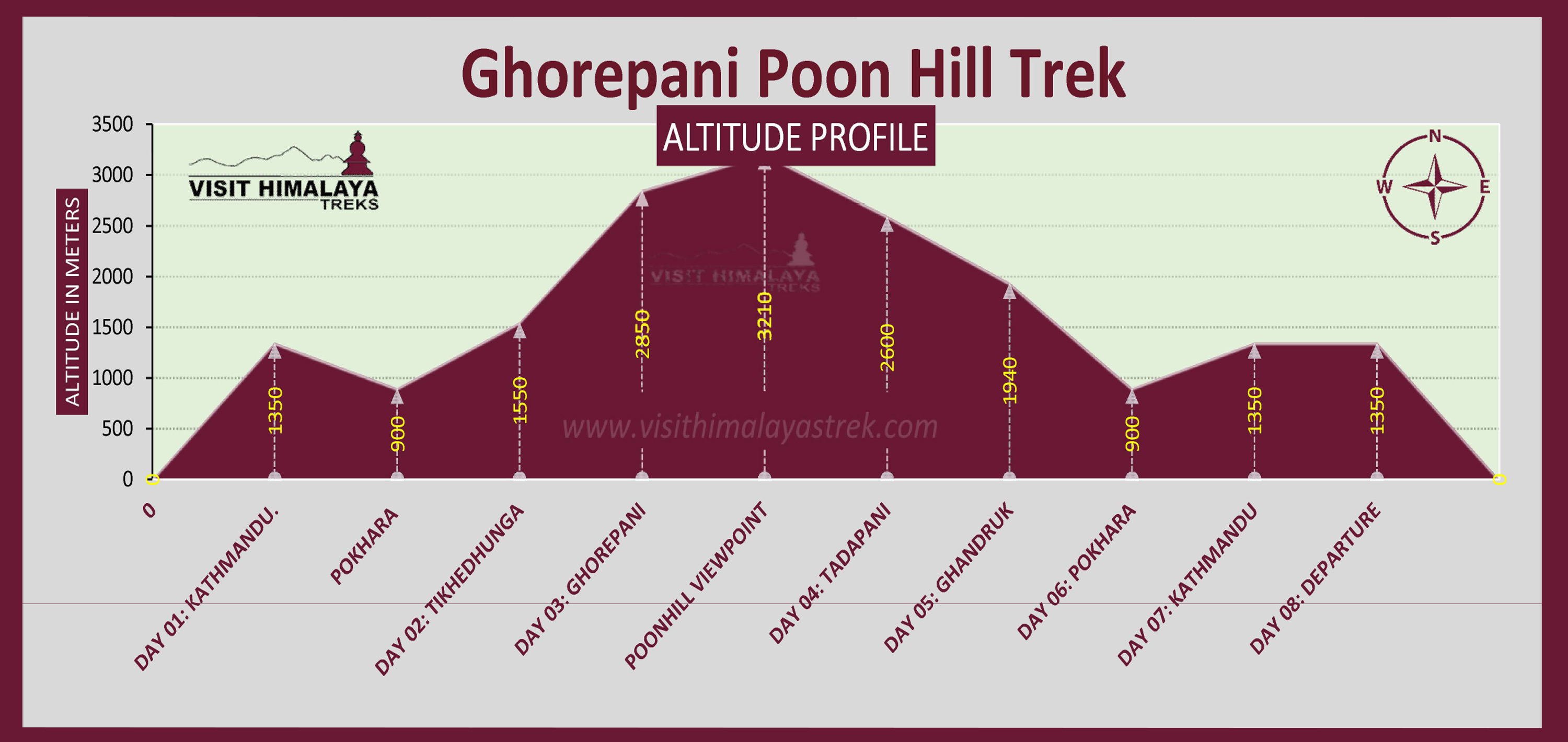
The Ghorepani Poon Hill trek, located in the Annapurna Sanctuary, has gained popularity for treks in Nepal due to its easy route. It is an ideal choice for inexperienced hikers and those looking for an introduction to trekking in Nepal. The trek can be completed in 8 days and offers well-marked trails with numerous guesthouses and restaurants along the way. Poon Hill itself serves as a great acclimatization trek before attempting more challenging routes like the Annapurna Circuit or Annapurna Base Camp treks.
This trek allows you to experience the lower part of the Annapurna Range through a circular route. The highlight is reaching the summit viewpoint of Poon Hill at sunrise, offering panoramic views of the famous Annapurna region. The trail takes you through rhododendron forests, terraced slopes, paddy fields, and lush vegetation. The warm hospitality of the local Gurung and Magar villages adds to the overall enjoyment.
Ghorepani is a village located within the Annapurna Conservation Area, sitting at an altitude of around 2874 meters. The trek is also known as the Annapurna Sunrise Trek and includes exciting challenges such as ascending over 3000 stone steps at Ulleri. The journey also allows for relaxation in the hot springs of Jhinu after a day's hike and exploration of the vibrant town of Pokhara. This less-than-a-week trek offers beautiful mountain scenery, charming villages, and a chance to witness the magnificent Himalayas, including Machapuchare, dominating the skyline.
The Ghorepani Poon Hill trek is considered the ultimate short trek in Nepal Himalayas. Even experienced trekkers find this trek to be a delightful introduction to the Himalayas, especially if time is limited. The accommodation along the route is comfortable, and the local cuisine is satisfying. The natural beauty of the mountains never fails to impress and provides ample opportunities for photography. The Ghorepani Poon Hill Trek, one of the best destinations for treks in Nepal offers a perfect short and beautiful journey in the Annapurna region. It is highly recommended for travelers of all age groups.
Pikey Peak Trek - Hidden destination rich in Culture and History lower valley of the Everest region.
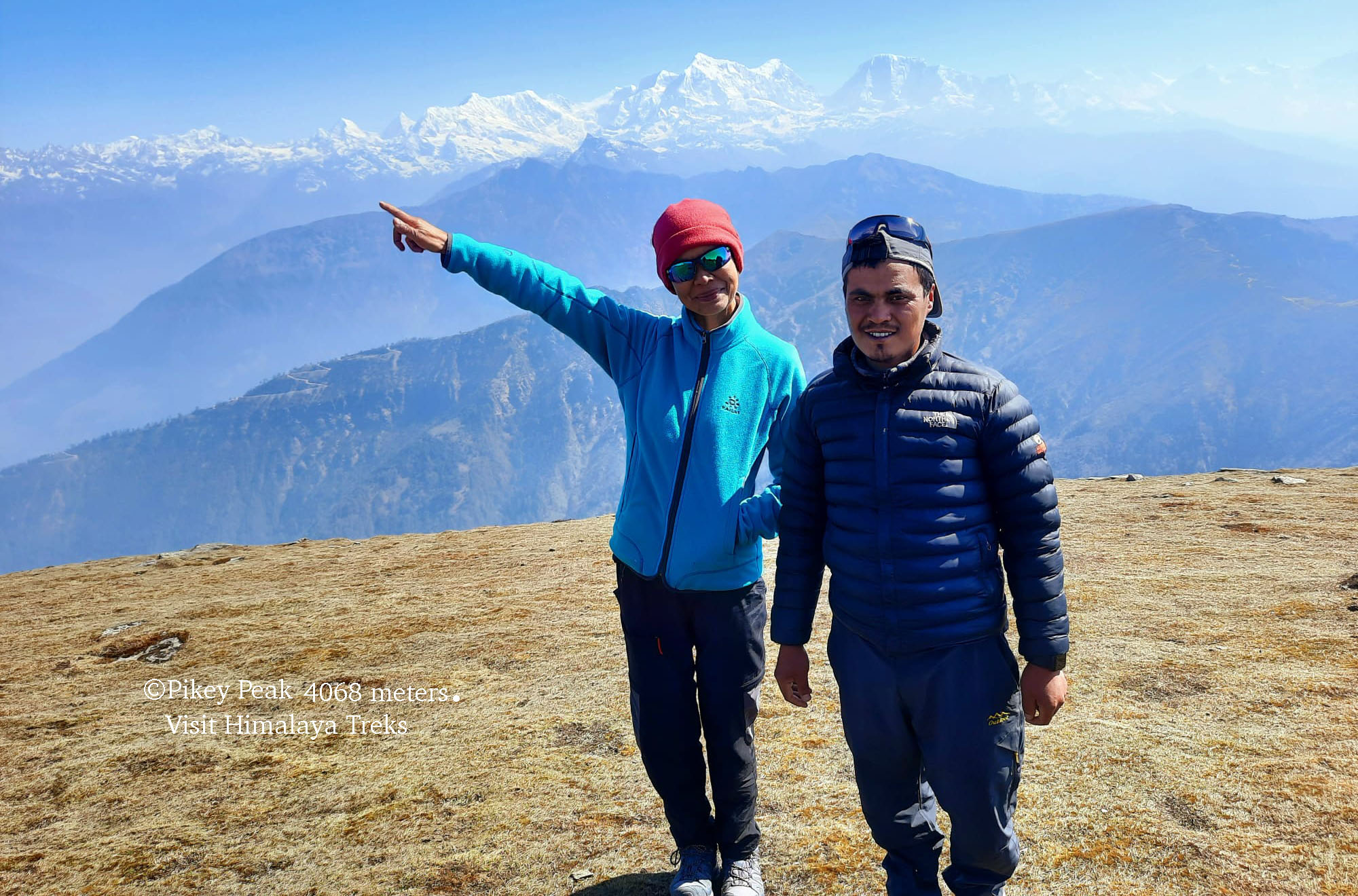
Pikey Peak Trek's Trip Fact.
|
Maximum Elevation:
|
4060 meters, Pikey View Point
|
|
Trek Duration:
|
09 days
|
|
Best Season:
|
March-May, and October- December
|
|
Trek Difficulty:
|
Easy
|
|
Accommodation Type:
|
Teahouse
|
|
Restricted Area:
|
No
|
|
Require Trekking Permits:
|
Trekkers Information management system (TIMS) Card
|
|
Starting / Ending Point:
|
Dhap / Phaplu
|
Pikey Peak Trek's Highlight:
- Trekking to Pikey Peak, known for its stunning sunrise and sunset views over the Everest and Makalu ranges.
- Off-the-beaten-path trail with fewer trekkers, providing a peaceful experience.
- Exploring the Sherpa culture, monasteries, and Buddhist heritage of the Solu region.
- Enjoying the hospitality of local Sherpa communities.
Pikey Peak Trek's Altitude Profile:
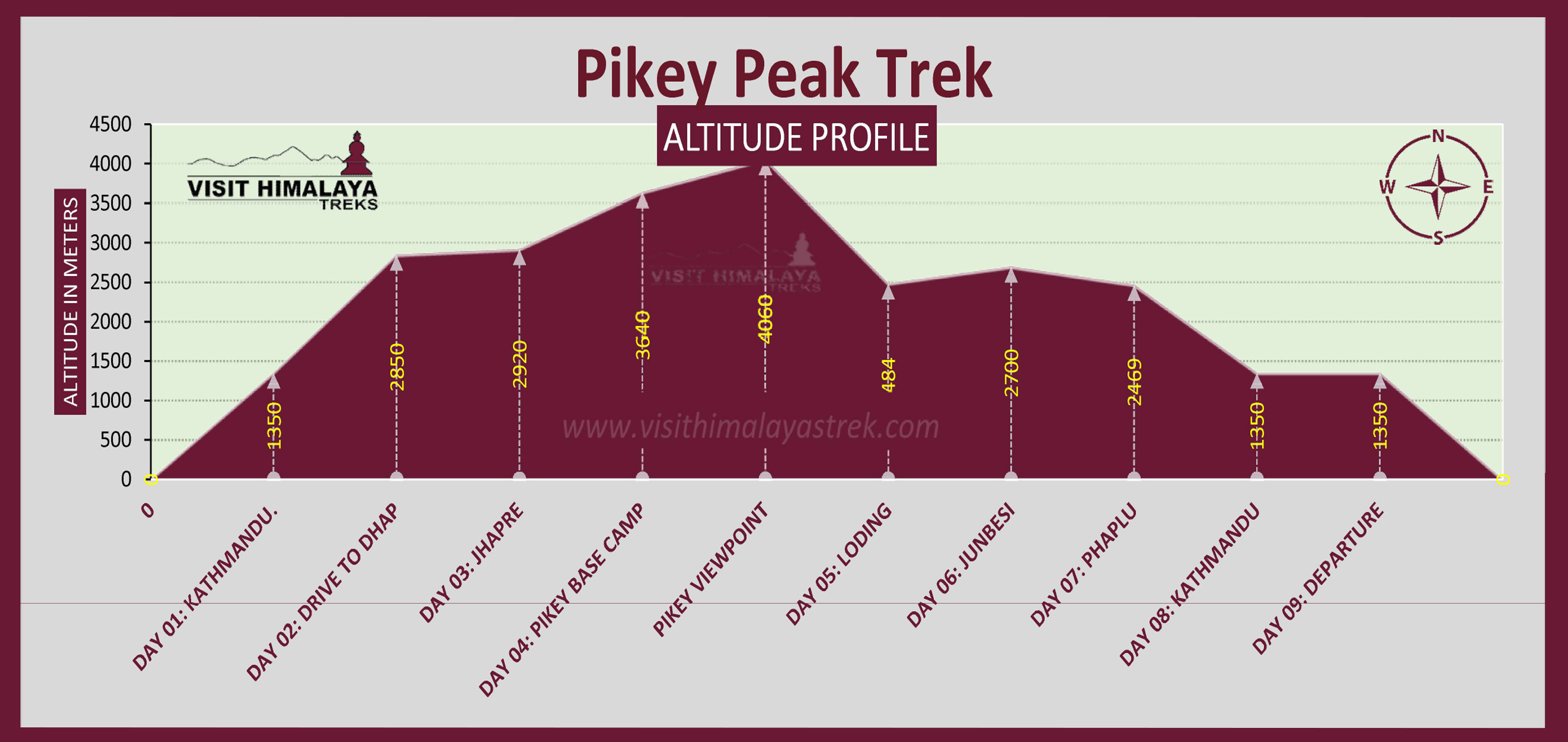
If you're looking for shorter treks in Nepal, specifically in the Everest region near Kathmandu, the Pikey Peak Trek is a great choice. This route is still relatively undiscovered, offering a unique and off-beat experience. If you're pressed for time or very fit, you can complete the trek in 3-4 days. However, a more leisurely 6-day trek allows for a more relaxed pace, providing an opportunity to visit Buddhist sites like monasteries, gompas, and stupas. Both itineraries offer stunning views of the Numbur Himal range and Everest. While it's difficult to say if it's the best view of Everest in Nepal, it's definitely worth seeing for yourself.
This journey, one of the best treks in Nepal is considered the best spot to witness Everest by many trekkers and even Sir Edmund Hillary, the first person to summit Everest, claimed it as his favorite spot to enjoy the mountain. The name Pikey is derived from the local Sherpa Clan deity, symbolizing the sky over nature. The Pikey Peak Trek is a recently established trail in the Khumbu region, offering close-up glimpses of Everest and the lower Khumbu area. The trek showcases magical landscapes and offers unforgettable moments of witnessing the sunrise and sunset over the majestic peaks.
Along with the Himalayan views, you'll have the opportunity to explore the unique geography and the vibrant Sherpa culture, known for their intriguing hospitality. With its lesser-known status, the Pikey Peak Trek provides a unique and solitary trekking experience. Upon reaching Pikey Peak, you will be amazed at awe-inspiring vistas of prominent mountain peaks such as Dhaulagiri, Everest, Makalu, and Kanchenjunga in the distant western region. The accommodations along the trek are simple tea houses with basic facilities.
The Pikey Peak Trek is an extraordinary and recently uncovered trekking trail within the Everest region. It offers a less traveled path and provides breathtaking views of Everest and other prominent peaks. Whether you opt for the shorter or longer itinerary, this trek promises an unforgettable adventure in the heart of the Himalayas.
Langtang Valley Trek - One of the popular Short Treks in Nepal.
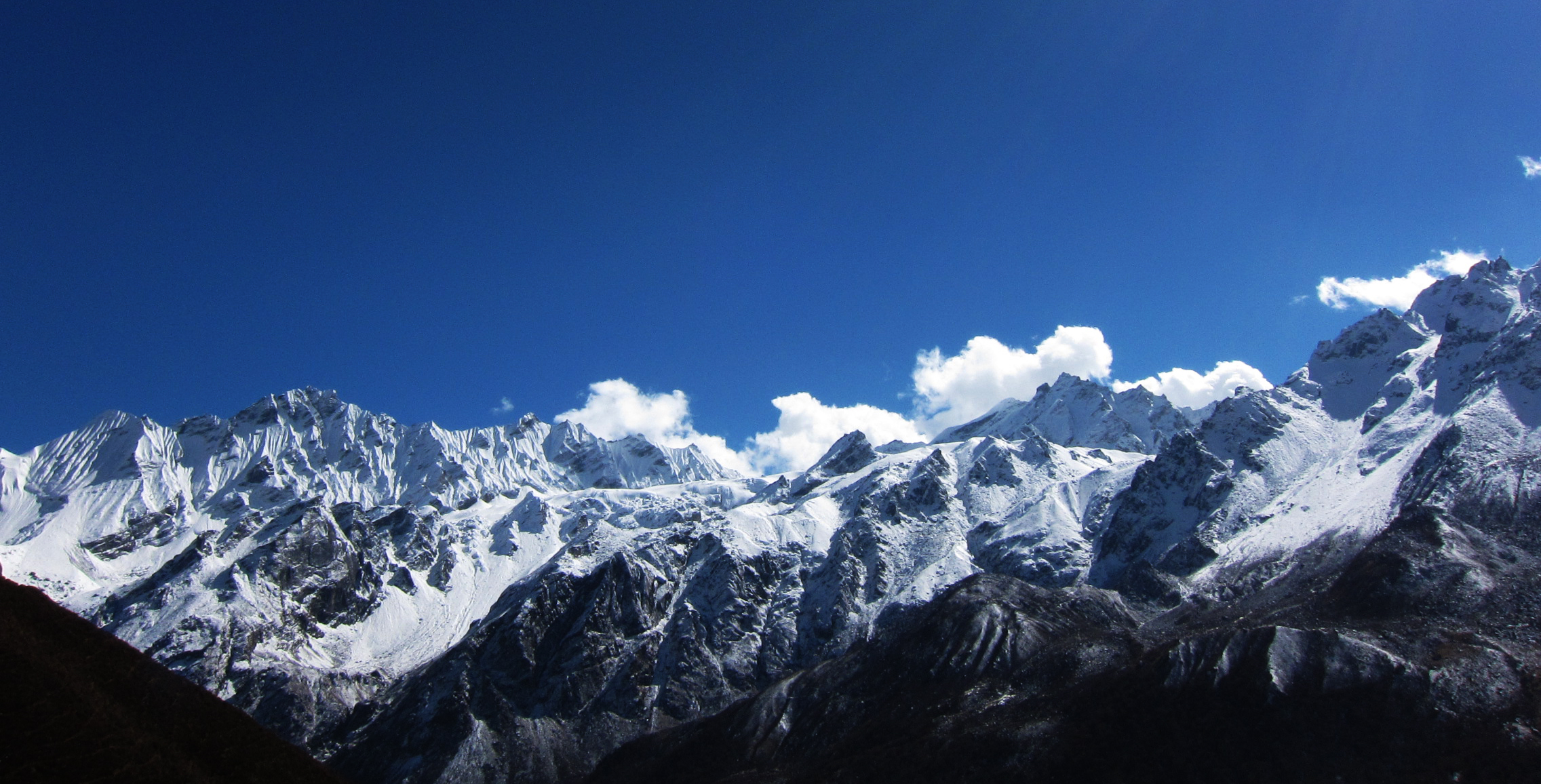
Langtang Valley Trek's Trip Fact
|
Maximum Elevation:
|
5033 meters, Kyanjin Ri
|
|
Trek Duration:
|
09 days
|
|
Best Season:
|
March-May, and October- December
|
|
Trek Difficulty:
|
Easy
|
|
Accommodation Type:
|
Teahouse
|
|
Restricted Area:
|
No
|
|
Require Trekking Permits:
|
Langtang National Park Entry Permits Trekkers Information management system (TIMS) Card
|
|
Starting / Ending Point:
|
Syabru Besi
|
Langtang Valley Trek's Highlight:
- Trekking in the Langtang region, close to Kathmandu, yet less crowded.
- Scenic landscapes with lush forests, alpine meadows, and glacial moraines.
- Visiting the traditional Tamang and Sherpa villages and experiencing their warm hospitality.
- Panoramic views of Langtang Lirung, Ganesh Himal, and other peaks.
Langtang Valley Trek's Highlight:
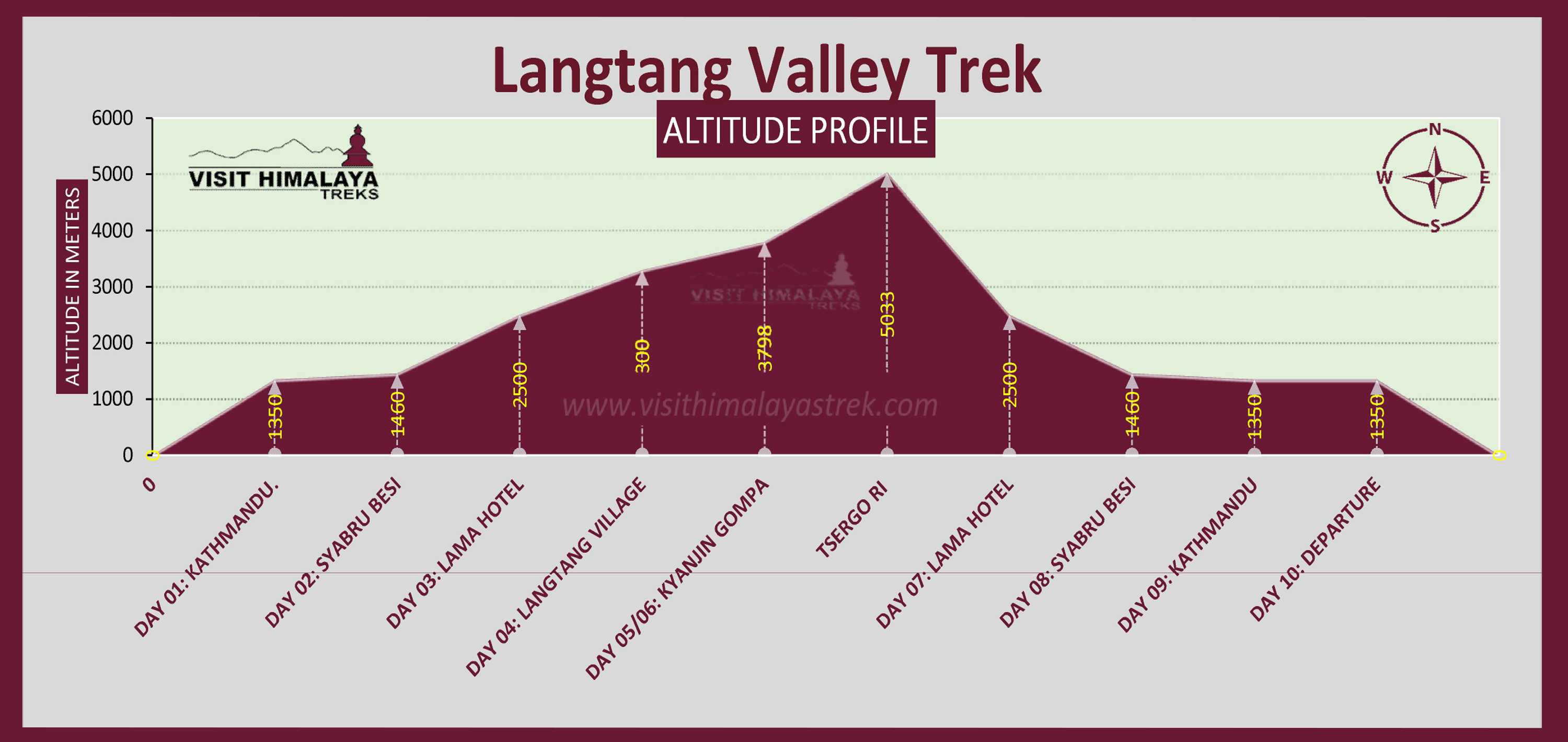
Langtang Valley Treks, a highly revered destination for treks in Nepal among travel enthusiasts and trekkers alike, is renowned for its stunning landscapes and breathtaking mountain vistas. It is also known as the "Valley of Glaciers trek" due to its thriving woodlands of pine, rhododendron, and oak, tranquil mountain streams, lush green slopes, and stone-strewn terrain. Langtang Valley is situated in Langtang National Park, the closest place to Kathmandu Valley where one can witness colossal snowy mountains and spectacular glaciers. It is the first Himalayan national park and provides a safe haven to numerous species of alpine vegetation and wildlife.
Langtang Valley Trek is a must-do adventure activity that takes you across the Langtang Valley, known as the "most beautiful valley in the world." It offers a majestic view of mountains with panoramic landscapes and is one of the top three most visited trekking destinations in Nepal. The trek provides opportunities to experience the mountainous lifestyle, Tamang culture, and the warm hospitality of the locals.
The trek begins from Syabrubesi and follows a leveled trail to Lama Hotel, passing through rhododendron forests and reaching the enchanting Langtang Valley. The valley is home to the native Tamang communities who follow the Bon and Tibetan Buddhism religions, providing trekkers with detailed insight into the native culture, values, and traditions. The trek continues to Kyanjin Gompa, where one can explore a beautiful monastery and a local cheese factory. A hike to Tserko Ri offers breathtaking views of glaciers and majestic mountains in close proximity. The trek then retraces the route back to Kyangjin Gompa, Lama Hotel, Syabrubesi, and finally returns to Kathmandu.
The Langtang treks in Nepal are relatively shorter but challenging, with long and steep ascents. It also serves as an excellent acclimatization trek for those preparing for more demanding and extended routes in the region. The trek offers a variety of scenery, from jungles with banana trees and monkeys to glaciers and ice peaks. It is an off-beat track that provides a unique and different experience from more touristy areas in Nepal. It is a perfect opportunity to create unforgettable experiences in the Himal and definitely one of the best destinations for treks in Nepal.
Jugal Himal Base Camp Trek - New and unique Trekking destination in Lape of Jugal Himal.
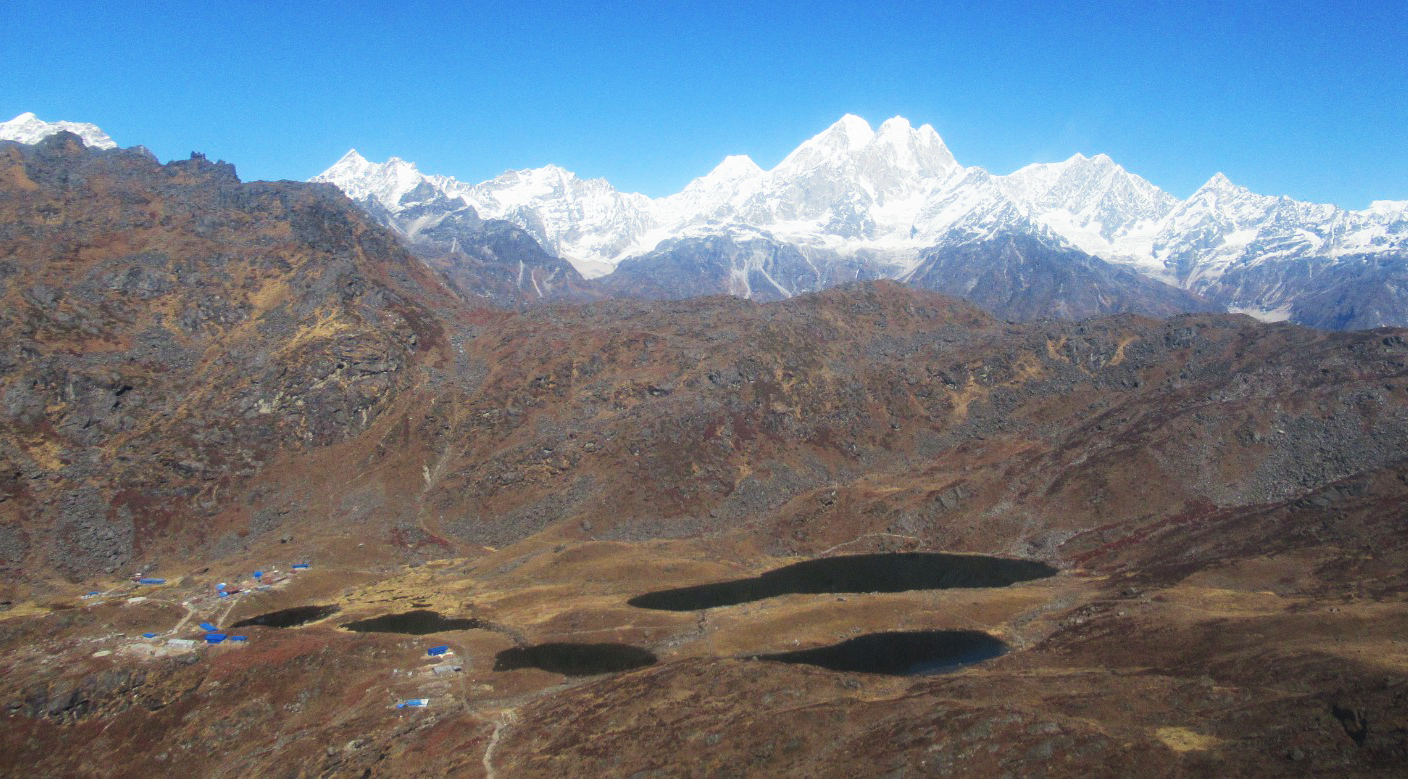
Jugal Himal Base Camp Trek's Trip Fact
|
Maximum Elevation:
|
4700 Meters
|
|
Trek Duration:
|
18 days
|
|
Best Season:
|
March-May, and October- November
|
|
Trek Difficulty:
|
Moderate
|
|
Accommodation Type:
|
Camping
|
|
Restricted Area:
|
NO
|
|
Require Trekking Permits:
|
Langtang National Park Entry Permits
Trekkers Information management system (TIMS) Card
|
|
Starting / Ending Point:
|
Thulo Bhotang / Kyangsing village
|
Jugal Himal Base Camp Trek's Highlight:
- The stunning scenery of mountains dusted with snow amidst beautiful surroundings.
- Explore the glistening lovely glacial lakes of Panch Pokhari and Bhairab Kunda.
- Adventure around remote corners of the Central Mountain range of Jugal Himal.
- On least ventured and hidden trails away from main popular trekking routes.
- Enchanting forest lined with tall rhododendron, magnolia, oaks, and pine trees.
Jugal Himal Base Camp Trek's Altitude Profile:
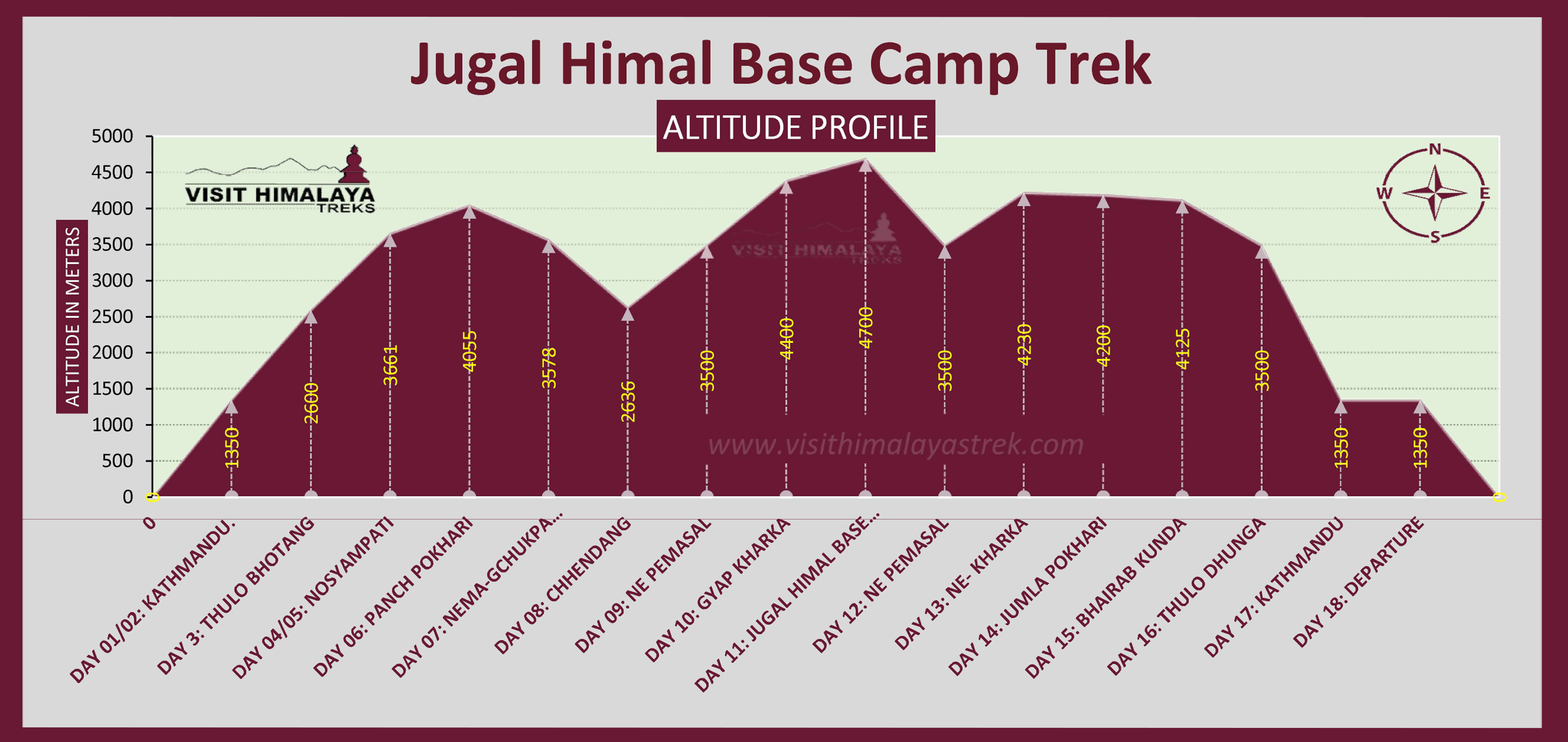
The Jugal Himal Trek is an off-the-beaten-path and serene adventure, revealing the majestic Himalayas, such as Dorje Lakpa (6866m), Gaurishankar (7134m), and the Langtang Ranges. This 18-day trek unveils charming villages, verdant forests, sacred lakes nestled at high altitudes, and the genuine hospitality of the Tamang and Sherpa communities. The trek provides a glimpse of the hilly landscape and the mixed culture of the region.
Starting with a scenic drive from Kathmandu to Chautara, the trek begins in Syaule. It offers both camping and tea-house accommodations. The Jugal Himal Trek is ideal for those seeking a serene nature experience away from the usual hustle and bustle. The journey takes you through enchanting places like Kami Kharka, Chyochyo Danda, and Hile Bhanjyang towards Panch Pokhari, a collection of five beautiful glacial lakes situated at higher altitudes. Panch Pokhari holds religious significance for both Hindus and Buddhists, attracting many visitors, especially during Janai Purnima.
During the trek, you'll encounter Sherpa and Tamang's villages nestled amidst the high Himalayas. These remote traditional Tamang villages offer insights into the ancient culture and traditions of the Tamang people. The warm hospitality of the locals makes you feel like part of their family. Along the way, you'll also come across Tibetan monasteries and encounter Lamas as you journey toward Bakhang Gompa. The trail passes through pine, fir, and rhododendron forests, showcasing Nepal's great biological diversity.
The Jugal Himal Trek allows you to escape the bustling city of Kathmandu and fully immerse yourself in nature, appreciating its incredible beauty and geographical diversity. Although 18 days may not be enough to fully explore this masterpiece of nature, it offers a taste of Nepal's diverse flora, fauna, and landscapes.
Conclusion :
Ultimately, the best treks in Nepal depend on your personal preferences, fitness level, and the kind of experience you seek. Whether you are looking for dramatic mountain scenery, cultural immersion, or remote wilderness, Nepal has something to offer for every trekking enthusiast. So, lace up your boots, prepare your backpack, and embark on a memorable journey in the Himalayas of Nepal.
If you need any help to make your journey more inspiring and memorable, contact Visit Himalaya Treks. For all the listed destinations for Treks in Nepal, VHT has first-hand experience and providing service since 2008.

